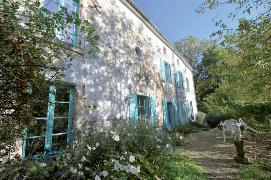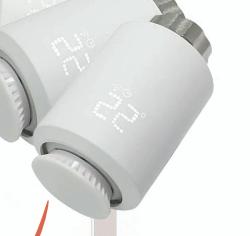








CONTACT US:






Tel: 05 17 36 15 32
editors.etcetera@gmail.com www.etceteraonline.org
17 rue des Chaumettes 86290 St Léomer
etcetera magazine @etceterafrance
This month we proudly bring menopause issues to the forefront, helping to highlight a much-neglected subject. The more information and conversations
The nights are drawing in, and it’s time to put our clocks back an hour (2am on Sunday 27 October). Be sure to check out Kristian’s article on creating the
15 SAMU (Medical)
17 Gendarmes (Police)
18 Pompiers (Fire and also trained in medical emergency)
112 European emergency not always English 114 Text-message emergency number for deaf/hard of hearing
119 Child abuse
115 Homeless
Annual

Commercial adverts: Please see our Media Pack at www.etceteraonline.org
What’s On/Listings: 12€ per 50 words for a guaranteed spot or free (space permitting)
Classified listing: 6€ per 25 words plus 3€ per photo
Property listing: 10€ per 50 words plus 6€ per photo
Code APE 5814Z Edition de Revues et Periodique Siret 80903463000016. La Présidente G. Feasey
Registered. Le Bourg, 87360 Verneuil Moustiers. Impression: Rotimpres. Pol. Ind Casa Nova. Carrer Pla de l’Estany s/n. 17181 Aiguaviva (Girona) Espagne. etcetera est gratuit.
While we always do our best to ensure the content in this magazine is given in good faith and businesses are reputable, we accept no liability for any errors or omissions and do not endorse any companies, products or services. Articles written are the personal opinions of the original authors and do not necessarily reflect the views of etcetera magazine.

113 Drugs and alcohol 1616 Emergency- Sea & Lake 3131 Last incoming call, key ‘5’ to connect
Orange
English speaking helpline
0033 (0)9 69 36 39 00
Website in English: www.orange.com/en/home
Technical assistance for landlines (French): 3900 (+33 9 69 39 39 00 from abroad)
SFR 1023 or 00336 1000 1023 (Not English)
EDF 8am to 8pm, Monday to Saturday. +33 (0)9 69 36 63 83 EDF Helpline in English 0033 562164908 (From UK)
E-mail: simpleenergywithedf@edf.fr
CPAM - 09 74 75 36 46
Veolia Water Emergency No: 24h/24 et 7j/7 05 61 80 09 02 (press 1 for urgent problems or 2 for a technician)
S.E.P Du Confolens (Water)
05 87 23 10 08 Emergency 24/7
Aéroport Int’l Limoges 05 55 43 30 30
SNCF (train times, buying tickets etc) 36 35
Credit Agricole English Speaking Helpline
Charente (residents only) 05 45 20 49 60
Alcoholics Anonymous
For contact details of meetings in your area including those conducted in English, visit www.aafrance.net
SSAFA France 05 53 24 92 38 email france@ssafa.org.uk
download
05 55 05 55 55 Limoges (CHU)
05 55 43 50 00 St Junien
05 55 47 20 20 Bellac
05 49 44 44 44 Poitiers
05 45 24 40 40 Angoulême
05 49 32 79 79 Niort
05 45 84 40 00 Confolens
Bereavement Support Network
English speaking support group for guidance on coping with bereavement in France. Personal and practical advice. www.bsnvar.org
Women for Women in France offering support to foreign-born (non-French speaking) women dealing with domestic abuse www.womenforwomenfrance.org
Counselling In France Counsellors, psychotherapists, NLP, CBT etc offering therapy in English to expatriates all over France on www.counsellinginfrance.com
French Health Insurance Advice line
CPAM English speaking Advice line: 09 74 75 36 46 (from France) 0033 974 75 36 46 (from other countries). The line is open from Monday to Friday, from 8:30 a.m. to 5:30 p.m.
NHS website : www.nhs.uk/using-thenhs/healthcare-abroad www.ameli.fr
No Panic France Helpline: No Panic UK helpline: 0044 1 952 590 545 11h - 23h (French time) 7/7 www.nopanic.org.uk /nopanicfrance@orange.fr
English-speaking Mental Health Line
SOS- HELP 01 46 21 46 46 3pm-11pm 7/7
British Consulate in Paris 01 44 51 31 00
British Consulate in Bordeaux 05 57 22 21 10 www.ukinfrance.fco.gov.uk/en/






















































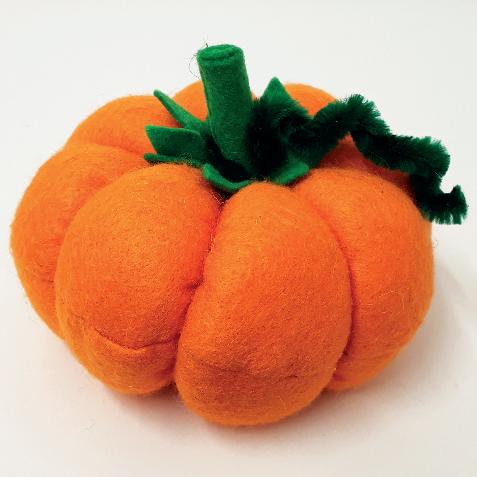

MAKE PUMPKINS THAT WILL LAST FOREVER! THE CUTEST HALLOWEEN ACCESSORY WITHOUT ALL THE MESS
Love pumpkins but don't really like gutting them? Consider sewing yourself a pumpkin. Doing this for
Materials:
Felt or fabric
(orange, green or white)
General needle + thread
Extra-long needle (for tufting)
Steps
1. Cut 2 identical circles in felt or fabric any size you like (just consider that you have to stuff your pumpkin later). You can use a compass or simply draw around a kitchen plate or bowl (don't forget to account for a seam allowance of at least 1 cm that will disappear into your finished pumpkin).
2. Sew the circles right sides together (RST) around outside edge, sewing
kids? Why not sew a face on the front! Interior decoration only and not edible (obviously…).
Stuffing (toy stuffing, cotton wool, old pillow stuffing or any other)
Optional green pipe cleaner for curly tendril

approx. 1 cm in from the edges (seam allowance) and be sure to leave a gap of at least 5 - 6 cm to turn your pumpkin through in the next step. Back-tack or tie a good knot at each end so your pumpkin doesn't burst whilst you stuff. Turn your pumpkin through the gap so that the seams are on the inside and run your finger around the edge inside to keep the circular shape.




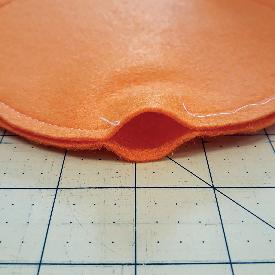


3. Fill your pumpkin full to bursting with stuffing.
4. Sew the gap closed using a neat hand stitch and plump. Your pumpkin may resemble a donut right now but have faith!
5. Now for the fun part of tufting your pumpkin. Using a long needle and thread, create a knot and then stab your pumpkin (donut) right through the middle and out the other side. Push the needle back through to where you started, pull taught and secure with a knot.
6. Keep a tight hold on your thread as you now wrap over your pumpkin and pierce through the centre repeatedly until you have 8 segments. Then tie a final knot to secure everything.
7. To make a stem just roll a small rectangle of green felt and sew along the joining edge to stop it unfurling.
8. To add a leaf cut a shape in felt and this can sit under the stem (this is best in felt as it doesn't fray).



Join stem and leaf together and then to the top of your pumpkin.
9. Finally, if you want a curly pumpkin tendril, wrap a green pipe cleaner around a pencil tightly and then gently slide the pipe cleaner off and you should have a curly tendril which you can secure to the top of your pumpkin.
Et voila ! You have yourself a super cute pumpkin. Now have some fun with different colours and sizes to create an autumn display.




ByLinziHannam

Linzi is a designer and teacher over at Frecklesandco.com she moved to France in 2023 and now lives in the Haute-Vienne with her family and a trillion stray cats. She is an avid crafter and a self professed sewing addict who loves to create and share her process

Find sewing and craft inspiration at www.frecklesandco.com
Email me: linzi@frecklesandco.com
Follow my sewing diaries on Facebook @frecklesandcocraft


Christie’s EI OCTOBRE ROSE à GENÇAY Town animations throughout October




1 Rue du 19 Mars 1962 87150 Oradour sur Vayres
EVERY SATURDAY WE’LL DONATE ALL TEA ROOM PROCEEDS TO SUPPORT THE FIGHT AGAINST BREAST CANCER! Please come & help us!
DothinkofReservingyourCakesinadvance!
CLOSED TUESDAY 1st OCT (Stocktake) REOPENING WEDS 2nd OCTOBER with our unbeatable ranges of BEAUTIFUL CHRISTMAS CARDS! Relations,CharityPacks,Boxes
CLOSED PM of FRIDAY 18th OCT (Health Rdv) ANNUAL LEAVE from Tues 29th Oct Reopening FRIDAY 15th NOVEMBER!
www.chezchristies.fr 05.49.50.61.94


Custom Framing for Arts, Crafts & Memorabilia Picture framers to La Galerie de Gabriel
John Selley EI - 09 77 00 66 38 Email: encadrement.oradour@gmail.com Encadrement d’Art


All Styles, All Ages, Beginner to Advanced
email: info@mattcowe.com web: mattcowe.com Facebook: mattcowemusic




Saturday 9 November 10h-15h Sunday 16 November 10h-15h
Huge selection of stunning HOMEMADE GIFTS by LOCAL ARTISANS PLUS locally made cakes and savoury & sweet pastries
1 route des prés Guillon, 79190 Melleran Denise 06 75 89 95 55 or email denise.eyre@wanadoo.fr Refreshments Offered



« Promenons-nous dans les bois…. ! ». Qui ne connaît pas l’histoire du Petit Chaperon Rouge ?
"Let's take a walk in the woods...!" Who doesn't know the story of Little Red Riding Hood?
Cette année, du 22 septembre au 21 décembre, c’est l’automne dans notre hémisphère, l’une des 4 saisons (le printemps, l’été, l’automne, l’hiver).
This year, from 22nd September to 21st December, it's autumn in our hemisphere, one of the 4 seasons (spring, summer, autumn, winter).
En campagne ou à la montagne, on trouve des promeneurs (des personnes qui aiment se promener) à la découverte des chemins (petites voies dans la nature) pour faire des balades (des promenades) ou des randonnées (à pied ou à vélo). Le matériel indispensable des promeneurs, ce sont les chaussures de marche, les jumelles et l’appareil photo.
In the countryside or in the mountains, there are walkers (people who like to walk) discovering the paths to take for walks or hikes (on foot or by bike). The


essential equipment for walkers is walking shoes, binoculars, and a camera. En effet, dans nos campagnes, il n’est pas rare de voir au loin un chevreuil, une biche voire un cerf. Nous sommes d’ailleurs dans la saison pour écouter le brame du cerf (il attire les femelles avec son cri que l’on peut entendre de loin pendant la saison des amours).
Indeed, in the countryside, it is not uncommon to see a roe deer, a doe or even a deer in the distance. It’s also the season to listen to the deer's belling (it attracts the females with its call that can be heard from afar during the mating season).
limaces…, et autour d’un point d’eau, il peut y avoir des libellules, des grenouilles et des crapauds…
In the woods, you can also find hares, wild boars, foxes, hedgehogs, squirrels, snails, slugs..., and around a watering hole, there can be dragonflies, frogs and toads….
Et dans la forêt, il y a aussi toutes sortes d’oiseaux, comme des merles, des moineaux, des rougesgorges, des pies, des chouettes des bois, des hiboux, des geais, des mésanges.…
Dans les bois, on peut trouver aussi des lièvres, des sangliers, des renards
And in the forest, there are also all kinds of birds, such as blackbirds, sparrows, robins, magpies, wood owls, owls, jays, tits….
Dans les bois, on peut trouver aussi des lièvres, des sangliers, des renards, des hérissons, des écureuils, des escargots, des
Bonne saison et à bientôt ! Isabelle
Élargissez vos horizons avec CONTINENTAL HORIZONS ! Broaden your horizons with CONTINENTAL HORIZONS!
Isabelle works for CONTINENTAL HORIZONS Language Centre in L’Isle Jourdain 86. She is a specialist Teacher of French as a Foreign Language with over than 27 years’ experience.
Do not hesitate to contact her on 06 20 10 34 49 or 05 49 84 17 73
Learn French with Continental Horizons! Contact us by email: continentalhorizons@free.fr
Dès que les jours raccourcissent, les arbres commencent à se préparer à l'arrivée de

Certified Legal Interpreting & Translating Coaching 15 Place d’Armes 86150 L’Isle Jourdain
Tél. 05 49 84 17 73
Email: continentalhorizons@free.fr

l'hiver en cessant de produire de la chlorophylle, d’où les couleurs qui changent.
Qu’il est agréable à cette saison de découvrir les couleurs automnales des arbres. Ces couleurs jaunes, oranges, rouges, si particulières, comme dans ces arbres : le chêne, le hêtre, l’érable, le marronnier, le châtaignier….
red colours, so particular, as in these trees: oak, beech, maple, horse chestnut, chestnut….
Nous pouvons en ramasser comme le cèpe, la girolle, la trompette-de-la-mort….
As soon as the days get shorter, the trees start preparing for the arrival of winter by ceasing to produce chlorophyll, hence the changing colours. How pleasant it is during this season to discover the autumn colours of the trees. These yellow, orange,
À cette saison, on parle de l’été indien. L’été indien ou l’été des Indiens (expression d’origine nord-américaine, en France on parle d’été de la Saint-Martin) est une période de temps ensoleillé et radouci, avant les premières gelées de l’automne et juste avant l’hiver.
At this time of year, we talk about the Indian summer. The Indian summer or the summer of the Indians (an expression of North American origin, in France we speak of the summer of Saint-Martin) is a
period of sunny and milder weather, before the first frosts of autumn and just before winter.
C’est également la saison des champignons. Nous pouvons en ramasser comme le cèpe, la girolle, la trompette-dela-mort….
Il est toujours bon, quand on a des doutes sur la comestibilité d’un champignon et pour ne pas se rendre malade de se faire conseiller auprès d’une pharmacie ! It is also mushroom season. We can collect them such as ceps, chanterelles, horn of plenty …. It is always good, when you have doubts about the edibility of a mushroom and in order not to make yourself sick, to get advice from a pharmacy!


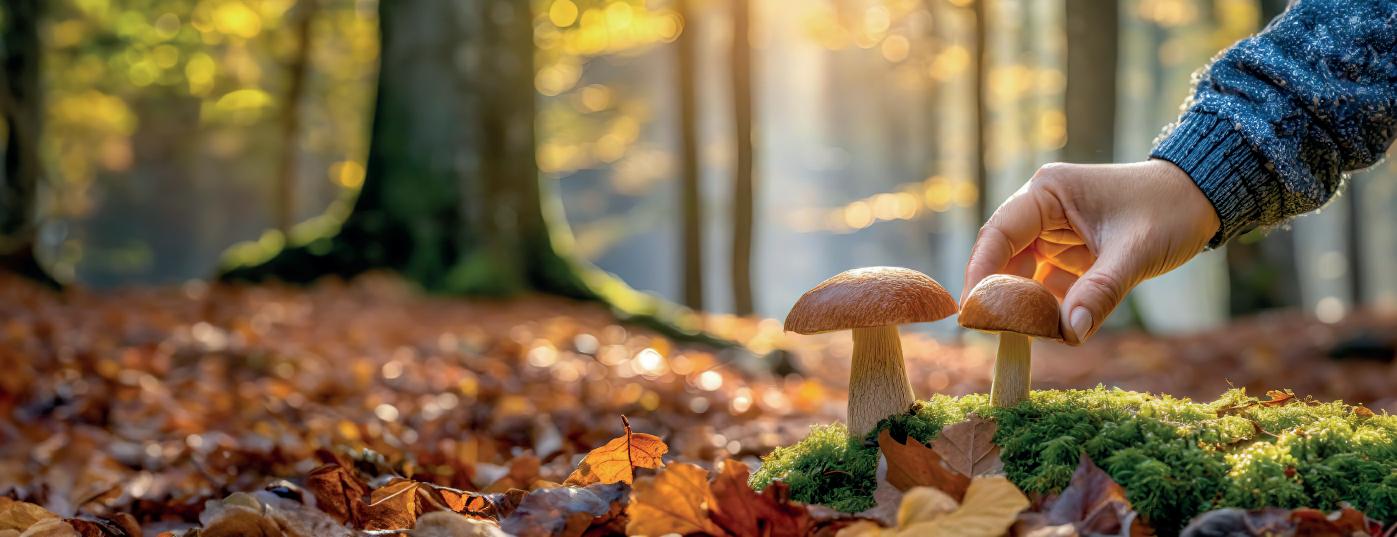

se promener (verb) to go for a walk les bois (m, pl) the woods le Petit
Chaperon Rouge Little Red Riding Hood
une saison a season le printemps spring
l’été (m) summer
l’automne (m) autumn
l’hiver (m) winter
en campagne in the countryside à la montagne in the mountains
un promeneur a walker un chemin a path
une voie a way
une balade a stroll
une promenade a leisurely walk
une randonnée a hike les jumelles (f, pl) / une paire de jumelles binoculars au loin far away un chevreuil a roe deer une biche a doe voire and even / or even un cerf a deer le brâme du cerf the belling of the deer
attirer (verb) to attract un cri a shout / a noise made by animals un lièvre a hare un sanglier a wild boar un renard a fox un hérisson a hedgehog un écureuil a squirrel un escargot a snail
une limace a slug
un point d’eau a water area
une libellule a dragonfly
une grenouille a frog un crapaud a toad
un oiseau / des oiseaux a bird / birds un merle a blackbird
un moineau / des moineaux a sparrow / sparrows un rouge-gorge a robin
une pie a magpie une chouette des bois a wood owl / a brown owl
un hibou / des hiboux an owl / owls un geai a jay
une mésange a tit
raccourcir (verb) to shorten

le chêne oak tree
le hêtre beech tree
l’érable (m) maple tree le marronnier horse chestnut tree le châtaignier sweet chestnut tree
une gelée a frost (weather) un champignon a mushroom ramasser (verb) to pick up (from the ground) le cèpe cep / boletus la girolle chanterelle mushroom la trompette-dela-mort horn of plenty (mushroom)
avoir des doutes (verb) to be in doubt la comestibilité the edibility se rendre malade (verb) to make yourself ill se faire conseiller (verb) to take advice








OCTOBER AND ITS COOLER TEMPERATURES SEE US RETURNING TO THE WARMTH OF THE KITCHEN AND CREATING DELICIOUS AUTUMNAL MEALS
Achill is in the air and now it’s time to warm up from the inside with some tasty and comforting meals.
We start with a flavourful soup, going into delicious braised cabbage, a catch of a boar leg, and finish with a welcoming easy-to-make dessert.
*Salt and pepper to taste means 1 to 2 cracks from the spice grinder
With never ending options for soups this one stands out. Sweet and rich pumpkin foundation with dynamic Southeast Asian flavours will add depth to your meal. Both comforting and invigorating it is a quintessential autumn dish.



Eric, a chef de cuisine of 20 years. Originally from Florida he is now based in the Limousin & caters all of France
www.chefericleclere.com
Instagram.com/chef_eric_leclere
Ingredients (serves 6 - 8)
1 medium sized pumpkin
1 red onion diced
1 tbsp sage
1 bunch parsley
2 bay leaves
1 bunch thyme
6 cups vegetable broth
1/4 cup red curry paste
1/3 cup brown sugar
1 litre crème entière
3 tbsp EVOO (extra virgin olive oil)
3 tbsp white wine
Salt and pepper to taste
Method
1. Cut the pumpkin in half and hull out all the seeds and guts. Then rub with EVOO and salt and pepper.
2. Place face down on a sheet tray and roast in oven at 180°C for 30 - 45 mins.


3. Once roasted, remove the pumpkin from the skin and pass through a strainer, then puree smooth using an immersion blender.
4. In a large pot add the oil and red onion and cook until translucent. Deglaze with white wine and allow the alcohol to cook off.
5. Add curry paste and mix.
6. Add the puree to the pot as well as the vegetable stock and cream.
7. Place all the herbs in a sachet and into the soup. Allow to simmer for 30 mins.
8. Adjust the consistency as needed. Then blend smooth with an immersion blender if desired.
* Garnish with roasted pumpkin seeds and cream.
As a side or a starter this braised cabbage is crunchy, warm, and delicious. The bacon and sausage add a flavour profile to the cabbage that reminds us of home. Chilly nights that need just a little warmth from the inside to fill us from the work of the day. Crispy enough to still give you the proper vegetable texture needed.
¼ head red cabbage
300 g bacon lardons
4 whole smoked sausage
4 tbsp orange juice
300 g brown sugar
4 tbsp apple cider vinegar
Salt and pepper to taste
Method
1. In a preheated heavy bottomed pot render bacon and sausage until brown.
2. When rendered add all other ingredients, stir well, and reduce heat to medium.
3. Cover pot for 1hr, remove lid and allow to reduce to desired consistency, more time will make it less soupy. Will also thicken slightly when removed from heat.
4. Serve warm as you don’t want it to get too mushy and congeal.
*Garnish with chives


Hearty food for a special season of transition. If you live here in France, you are probably familiar with the chasse. If you are in fact familiar with them then you have probably also benefited from the bounty. If not, you can always find great pieces like a boar leg at the nearest butcher or supermarket. So let’s learn how to enjoy this type of gift.
Ingredients (serving size varies)
1 boar leg
4 cups brown sugar
50 cl red wine (made into ice cubes)
1 bunch thyme
A lot of salt (enough to coat the leg)
1. Coat all sides of leg with 1 half (2 cups) brown sugar and salt.
2. Place in cooking tray with sides to keep in the juices.
3. Cook for 8 hours at 104°C.
4. Let stand and refrigerate. Once fully cooled place in sous vide bag with red wine ice cubes, thyme, the other half (2 cups) brown sugar, and a dash of salt.

5. Finish cooking using sous vide method with immersion circulator (water bath) another 12 - 24 hours at 73°C.
6. Let cool in the sous vide bag for 30 mins. Cut one corner of bag and strain juices into an appropriate pot, reduce by half. Pull meat off leg with two forks to shred over roasting pan, drizzle pan sauce over meat and serve warm. If not using immediately put into ice bath until fully cooled and into refrigeration, place bag into pot with hot water when ready to use.



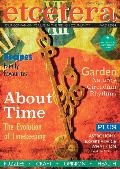

7. If you don’t have an immersion circulator set a large pot of water over low heat and measure with a jam thermometer until desired temperature.
8. You will need to adjust thermostat to achieve desired temperature, watch to make sure it doesn’t fluctuate too much.
9. Gently lower sous vide bag into water, remove with tongs and cool when finished. Make sure to watch thermometer closely during cooking.



SOUS VIDE
A method of cooking where you cook something in a hot water bath for a long time. You place your food into a plastic bag, squeeze all the air out (creating a vacuum), and then put the bag into a container of water. The container of water is kept at a constant temperature.
accommodation with luxury pool. Chambres d'Hotes,

Fluffy – Warm – Crispy – Buttery
Yes, all of that in one dish. A staple for the season in every household. A dessert that doesn’t weigh you down, but still satisfies. One for everyone in the home to enjoy
Ingredients (serves 6 - 8)
1-1/2 cups all-purpose flour
1-1/2 tsp baking powder
1/2 tsp salt
1/2 cup unsalted butter, softened
1/2 cup granulated sugar
2 tsp vanilla extract
2 large eggs
1/2 cup milk
Apple mixture:
1/2 cup light brown sugar (packed)
1-1/2 tsp ground cinnamon
1 large apple peeled, cored, and chopped into small pieces
Topping:
2 tsp brown sugar
1/4 tsp ground cinnamon
Glaze:
3/4 cups sucre glace
1/4 tsp ground cinnamon
2 tbsp water
Method
1. Preheat the oven to 180°C. Grease and flour a small loaf pan.
2. In a medium mixing bowl, whisk together the flour, baking powder, and salt. Set aside.
3. Using an electric handheld or stand mixer fitted with the paddle attachment, beat the butter, sugar and vanilla together, on medium-high


speed until smooth and pale (about 3 - 4 minutes). Scrape down the sides and the bottom of the bowl with a rubber spatula as needed.
4. Beat in the eggs, one at a time, until incorporated.
5. With the mixer on low speed, add about half of the flour mixture, alternating with half the milk. Add the remaining flour mixture and milk and mix to combine.
6. In a mixing bowl, combine the brown sugar, ground cinnamon, and apples. Set aside.
7. To make the topping, in a small bowl combine the brown sugar and cinnamon. Set aside
8. Pour half of the batter into the prepared loaf pan and top it with half of the apple mixture. With a knife or skewer, swirl through the batter lightly. Don’t overdo it. The bread looks better when it has a beautiful
thick layer of fruit and cinnamon sugar in the middle.
9. Pour the remaining batter on top and then the remaining apple mixture. With a knife or skewer, swirl through the batter a couple of times in both directions. Sprinkle the cinnamon sugar mixture on top.
10. Bake for about 45 - 55 mins or until a cake tester or toothpick inserted into the centre comes out clean. Only a few moist crumbs should attach to the cake tester or toothpick due to the soft apples in the centre. You can also leave cake tester in for 5 - 10 secs and place against your inner wrist, you should feel temperature difference.
11. Remove the bread from the oven and allow it to cool in the pan for about 15 - 20 mins. While the bread is cooling, whisk together the glaze ingredients. Remove the bread from the pan and place it on a cooling rack. Drizzle the glaze over the bread. Let the bread cool completely before slicing.


INDEPENDENT FINANCIAL ADVISER
deVere France
Preparing for retirement is a significant task, and it's wise to enlist the help of a financial advisor. Their expertise will assist you in setting realistic savings goals, understanding your financial requirements, and devising a comprehensive savings plan to achieve them. With a financial advisor, you can be confident in the management of your retirement savings.
Retirement planning is not a one-time event. It's a dynamic process that requires regular reviews. Life is unpredictable, and your needs and wants will evolve over time. This is why your retirement savings plan should be revisited on a regular basis. Things to consider when reviewing your retirement savings plan.
Retirement savings variables – Market volatility and life
No one can predict the future or say in what state the markets or an economy. It’s all a best estimate as to how your
retirement savings will perform over time. Market volatility and poor market performance could shrink your retirement savings. Ensure that your pension savings account is diversified to mitigate risk in the markets.
Plan for the worst-case scenario
You might suffer an illness or develop a health problem that requires extra care when you are older. Will your retirement savings cover this? It is better to over-plan than under-plan for retirement. This could be the right time to look into various kinds of life, disability, and critical illness cover to close this gap.
Retirement cost of living
Inflation has been at an all-time high, and the cost of living has skyrocketed over the last few years, leaving your cash with less spending power. This could have serious consequences on your retirement savings. You must review your retirement needs regularly as needs change over time. Your financial advisor needs to factor in the current cost of living and adapt your savings goals accordingly, otherwise, you might not be as financially secure as you want to be when you retire. Retirement destination might change As life happens, you might decide to retire

in a different country. This could be a country you have visited on vacation or worked in. This will affect your retirement income planning as the new country might have a lower or higher cost of living. Also, your tax situation will change as each country has specific rules about taxation and foreign pensions.
Longevity – Extending your retirement savings
It is better to over-plan than under-plan for retirement
People are living longer due to better medical care and medicines. This is great news for you but not your retirement savings. Where you planned for a 20-year retirement, you now need to plan for a 30year retirement. That’s a shortfall of 10 years’ worth of savings Plan for a longer period of time. There is nothing worse than running out of money during retirement or downgrading your lifestyle. It is essential to have regular reviews of your retirement savings portfolio to ensure that you achieve your retirement goals and not be left financially insecure.
Please note, the above is for educational purposes only and does not constitute advice. You should always contact your deVere advisor for a personal consultation. * No liability can be accepted for any actions taken or refrained from being taken, as a result of reading the above.


deVere France S.a.r.l. are regulated by ANACOFI-CIF and ORIAS which will only recommend French regulated products.


Helen Booth works as a financial adviser for deVere France S.a.r.l and has lived as well as owned property in the Deux-Sèvres region. Having worked in the financial services in the UK for over 15 years, Helen prides herself in being fully diploma-qualified for the services that she provides. Helen has lived and worked in France for over 8 years and enjoys being part of deVere France S.a.r.l., a division of one of the world’s leading independent financial consultancies, deVere Group.
With over $10 billion of funds under its advice and administration and with more than 80,000 clients around the world, deVere Group truly offers a myriad of unique products and notes that are not available anywhere else in the market.

deVere France can advise you on ways to help safeguard and increase your wealth, as well as helping with HMRC-recognised pension transfers to a Qualified Recognised Overseas Pensions scheme (QROPS) to give you potentially more flexibility in your pension plans.
If you would like to know more about how deVere France can help you, contact
Helen Booth DipPFS , EFA : +33 (0) 77 171 2879 : helen.booth@devere-france.fr
ou de
Catégorie B,
à l’Organisme pour le
en Assurance (ORIAS) numéro enregistré 12064640. Garantie Financière et Assurance de Responsabilité Civile Professionnelle conformes aux articles L 541-3 du Code Monétaire et Financier et L 512-6 et 512-7 du Code des Assurances. Registered name: deVere France S.a.r.l, registered company number RCS B 528949837, 29 Rue Taitbout, 75009, Paris, France. Gérant: Mr. Jason Trowles. Registered with ANACOFI-CIF (National Association of Financial Advisers). Registered number: E008176, association
brokers, Category B, registered with the Organisation for the Registration of Assurance Intermediaries (ORIAS). Registered number
conforms to article L 541-3

Allianz has a special insurance for luxury cars with some advantages not only in pricing but also with regards to the cover.
Which cars: Luxury cars which are cars valued between 50,000€ and 300,000€ including brands such as: Alpine, Aston Martin, Bentley, Bugatti, Caterham, Dallara, Donkervoort, Ferrari, Lamborghini, PGO, Lotus, Maserati, Maybach, McLaren, Morgan, Pagani, Pininfarina, Porsche, Rolls Royce, Shelby, TVR, Venturi, Z. Not included: BMW, Mercedes, Audi, and other cars such as Renault, Peugeot, VW, etc even if they are luxury versions.
If the car is more than 5 years old, Allianz does not accept diesel cars (I guess it is not luxurious enough!) but does accept Audi, BMW, and Mercedes as long as the value is above 150,000€ and below 300,000€. Who: only drivers above 30 years old (and not novice drivers) and with no more than one claim in the past 3 years (claims with bodily injuries are not accepted either).


The driver must have a ‘normal car’ insured to drive for everyday life. Premium advantages: Up to 65% discount on a normal premium for a luxury car. For example, a Porsche 911, year 1971 worth 100,000€, would cost 620€ per year to insure with no excess.
Breakdown cover advantages: your car will be taken to a specialist garage as opposed to the closest one if you break down or have an accident. And with no limit for tow costs.
Use advantages: You are insured to use the car on race circuits as long as it is not for a competition. And we can put the car in ‘garage mode’ when you decide not to use it for a long period (winter for instance) so that reduces the premium even more.
Conditions: You must have a recent valuation or the invoice of the car dealer to prove the value of the car.
Collection cars or bikes: If you have a collector’s car (over 30 years old) which is

either a diesel or valued less than 50,000€, then we use a special company with discounted premiums (a 2CV can be insured for less than 100€ per year). You must have a ‘normal day-to-day car’ insured and if the value is more than 50,000€ you must have a formal valuation. With this company you can also have one contract for all your vintage cars or bikes (if you have more than one).
Conclusion: With the Circuit des Remparts coming up this month, you might envisage purchasing one of those lovely old cars, so come to us!!
And remember to check out our website www.bh-assurances.fr/en for all my previous articles (‘practical information’).
11 rue du General Leclerc
16700 Ruffec
Tél:+33 (0)5 45 31 01 61
10 Bd du 8 mai 1945
16110 La Rochefoucauld
Tél:+33 (0)5 45 63 54 31
102Avenue de la République
16260 Chasseneuil sur Bonnieure
Tél:+33(0)5 45 39 51 47
2 Avenue de la Gare
16270 Roumazieres-Loubert
Tél:+33(0)5 45 71 17 79


ANGLO FRENCH HELP contact@anglofrenchhelp.com
In recent years there has been a sharp increase in the number of text message and email scams circulating in France. These scams, often cleverly disguised as legitimate communications from government agencies, delivery services, or social media platforms, are designed to trick recipients into revealing sensitive information, clicking malicious links, or making payments. The threat is real, and it’s important to know how to identify these scams, avoid them, and take action if you realise you’ve fallen victim to one.
Several types of scams are particularly prevalent in France, each designed to exploit your trust in official institutions or services.
Messages - One of the most common scams in France involves messages claiming that your Carte Vitale, the national health insurance card, is expiring. The message urges you to click a link to update your details, warning that failing to do so will result in the suspension of your health coverage. Or that your card has expired, and you need to pay a fee to receive a new one. However, government agencies will never ask you to update
an expiration date.
Speeding Fine Scams - Another common scam involves fake notifications about speeding fines. You may receive an email or text claiming you’ve been caught speeding and that you need to pay the fine immediately. These messages usually come with a link for payment or further details. If you ever have doubts about such a message, don’t click the link. Instead, go directly to the ANTAI (Agence Nationale de Traitement Automatisé des Infractions) website, where you can verify any legitimate speeding fines.
Links in scam messages often lead to phishing websites
that look similar to legitimate ones but with small differences. One red flag is if the message comes from a personal mobile number (starting with 06 or 07 in France) or a personal email address (ending in Gmail, Outlook, iCloud etc). Official organisations will never contact you from these types of addresses.
Fake Delivery Notifications - Many people in France have also reported receiving fake delivery notifications via text or email. These messages claim that a package is waiting for you but requires further action, such as confirming delivery details by clicking a link. Often, these links lead to phishing websites designed to steal your personal information or install malware on your device. Be cautious, especially if you weren’t expecting a delivery.
Fake Social Media WarningsScammers also target social media users with fake warnings that their accounts will be deleted unless they follow specific instructions, which typically involve clicking on a link. These scams aim to steal your login credentials or gain access to your account.
How to Avoid Falling for Scams
1. Verify the Sender Before taking any action on a suspicious message, verify
2. Avoid Clicking on Unknown Links - If you receive a message with a link, especially one that you weren’t expecting, resist the urge to click it. Links in scam messages often lead to phishing websites that mimic official sites but are designed to steal your personal information or install malware. Always navigate to official websites directly by typing the URL into your browser.
3. Never Share Personal Information
Legitimate organisations will never ask for sensitive information such as your password, bank details, or social security number via text message or email. If you’re asked for this type of information, it’s a clear sign of a scam.
4. Look for Signs of a Scam - Be on the lookout for subtle signs that a message might be a scam. These can include spelling or grammatical errors, urgent language (e.g., "Act now or lose access"), or offers that seem too good to be true.
5. Report Suspicious Messages - If you receive a suspicious message, don’t just ignore it, report it. In France, you can report scam messages to the platform

‘33700’ which is dedicated to fighting SMS fraud. You can also contact the organisation the scam is impersonating, such as your bank or a government agency, to alert them.
What to Do If You Realise You’ve Fallen for a Scam
1. Change Your PasswordsIf you clicked a link and entered login information, immediately change the passwords to your accounts, especially if you use the same password for multiple services. It’s a good idea to enable twofactor authentication for added security.
3. Run a Security Scan - If you clicked on a link that may have installed malware on your device, run a security scan using a reliable antivirus program. This can help identify and remove any malicious software that may have been downloaded.
Trust your instincts and do your own research
4. Report the Scam - Report the scam to the relevant authorities. In France, you can file a complaint with the "portail officiel de signalement des contenus illicites de l’Internet" (Pharos), which is a government initiative to fight cybercrime. You should also report the scam to your bank, or any service provider involved in the scam.
communications in the coming months.
2. Contact Your Bank - If you’ve given out any financial information, contact your bank or credit card company right away. They may be able to block fraudulent transactions or freeze your account to prevent further misuse.
5. Stay Vigilant - After falling for a scam, you may become a target for future scams. Scammers often share or sell the contact information of their victims to other cybercriminals. Stay alert and be especially cautious of any unsolicited
The rise in text message and email scams in France is a growing concern, but with the right knowledge and vigilance, you can protect yourself from falling victim. Always verify the sender, avoid clicking on unknown links, and never share personal information via unsecured channels. If you ever find yourself questioning the legitimacy of a message, trust your instincts and do your own research by visiting official websites or contacting the organisation directly. You can also contact me directly, and I can help you determine if it’s a scam or legitimate. And remember, if you do fall for a scam, acting quickly can make all the difference. Change your passwords, contact your bank, and report the scam to the authorities. By staying informed and vigilant, we can all do our part to stop these scammers in their tracks.



DONNA STOKES
FREELANCE PA & ADMINISTRATIVE SUPPORT
donnastokespaservices@gmail.com
“People
with goals succeed because they know where they’re going”
Earl Nightingale
In the world of small business ownership, success is often defined by growth, expansion, and profit, yet, for many entrepreneurs, the idea of ‘making it’ can differ from these conventional measures. Whilst it’s true that many aim for financial abundance or the rapid expansion of their business, others prioritise different values like flexibility, personal fulfilment, or a balanced lifestyle. In essence, the key to your successful business journey lies in defining what success means to you and defining goals that align with your personal vision. One of the biggest misconceptions is that success looks the same for every small business owner. In reality, goals are as diverse as the people who set them. For some, financial growth and expanding the business to new markets might be the ultimate goal. Others might define success as the ability to work from home or control their own schedules, have more family time or time to commit to hobbies, leisure activities or volunteering. Some might choose a sense of fulfilment by serving their local community, preferring to maintain a small, sustainable business, or prioritising work-life balance over growth and expansion.
Whatever the goal, the most important thing is to acknowledge and accept that these differences are completely valid. Success can look and feel different from one person (and their business) to the next - and that’s ok. There is no one-size-fits-all definition of success, and that’s what makes every entrepreneurial journey uniquely rewarding.
So what’s your goal? Have you spent time considering and defining it? What does it look and feel like? Sometimes it can be easy to fall into the day-to-day rhythm and routine of running your business without taking the time to look up and take a broader view. But it’s important to clarify your goal and what you want your business to do for you. Maybe start by
reflecting on why you started your business in the first place. Ask yourself some key questions, such as:
What motivated me to launch this business?
What do I want my business to achieve in the long run?
How do I define personal success?
For some business owners the goal might indeed be to grow into a large, profitable company, possibly to consider ultimately cashing in or selling the business in the medium to long-term. Others may simply aim to earn enough to live comfortably, while having the flexibility to spend more time with family or pursue personal passions. Whichever camp you fall in, understanding your ‘why’ is essential and it’s important to remember that success doesn’t have to mean working long hours or constantly expanding; it could mean the ability to work fewer days a week, take more holidays or even pursue other interests or hobbies.
your home office? Are you working fulltime or part-time?
Evaluate your values: Think about and identify the values that guide your decisions. Do you value financial independence, flexibility, creativity, or community involvement? Your values will help shape the kind of business you want to run.
Set specific, realistic goals: Based on your vision and values, try to get really specific about your goals. For example, rather than “I want to grow my business,” you might say, “I want to earn enough to comfortably support my family while working flexibly for around 4 days per week.”
One of the biggest misconceptions is that success looks the same for every small business owner
Most business owners will have an intuitive sense of their vision and goal, but it’s worth remembering that these can change over time too, so need revisiting periodically. If you’re struggling to define your goal, have a think about things like this…
Visualise your future: Imagine where you want to be in 1, 5, or even 10 years. Are you still working? What does your ideal workday look like? Are you managing a large team, or is it just you in
Consider the lifestyle you want: What kind of lifestyle does your business need to support? Is it just yours, or your family’s too? Do you have caring responsibilities? Do you want to travel? Have weekends free? Spend more time with family? Thinking about these things will help ensure that your goals fit with the life you want to achieve.
Ultimately, there’s no right or wrong way to define success as a small business owner. It’s deeply personal and varies from one entrepreneur to the next. By taking the time to define your unique goal and outlining a path to achieve it, you can make sure you’re building a business that not only meets your financial needs but also enhances your life in meaningful ways.

If you’re reading this as a British person living here in France, how do you describe yourself? I ask because I see ‘expats’ frequently applied to us and, although I’m sure many are happy with that label, I’ve never cared for it. For me, it carries an uncomfortable connotation, an echo of Britain’s colonial past. I may be overthinking it, but ‘expat’ is someone named Archibald Forbes-Gusset playing polo in Bengal; it’s noonday guns and ladies taking high tea while being fanned by a quietly seething local person. There’s a subtext of entitled superiority, like we’re out here flying the flag for King and country. I don’t like the word, is what I’m saying.
I guess you can make a case for its literal interpretation since an ‘expatriate’ is simply someone who has moved to another country. But as far as I’m concerned we are immigrants. For balance, I also detest being referred to as a ‘Brit’. This possibly stems from my general dislike of ‘chummy’ abbreviations or perhaps because the word appears so often in those Channel 5 programmes about being drunk in Ibiza. Although our nationality might arbitrarily place us in a defined group, throughout life we ally ourselves with other associations, other gatherings which indicate how we would like to be perceived. I’m fascinated by a couple of such collectives in America. Many people there – workers in the auto, coal and steel industries, farmers etc - have faced real hardship as they watched the sun going down on a standard of living they believed was theirs by right. As global markets shift and convulse, the ‘American Dream’, on whose promise they were raised, looks increasingly out of reach; the confidence with which their parents and grandparents faced the future is lost to them. In their fear and disillusion, they cried out for a saviour and around a decade ago one appeared in the shape of a coarse New Yorker. In truth, the man cared little for these struggling families but his appetite for attention is ravenous. Calculating that what they most desperately needed was hope, he baited his hook accordingly and simply reeled them in. He promised that, being uniquely gifted, he alone could fix the economy and restore their pride. He pledged to ‘Make America Great Again’, (MAGA), that fourth word feeding their angry nostalgia. The man’s record of racism and misogyny, not to mention multiple bankruptcies, was no barrier to his followers and in 2016 he rode their discontent all the way to the White House. Once there, however, a prisoner of his own bravado, he achieved
nothing, built nothing, solved nothing. He blamed his failures on an invented ‘Deep State’ conspiracy working against him. So, still they adore, still they believe.
Just as intriguing to me, though, is the equally passionate support for this same candidate from the self-titled ‘Christian Right’, an umbrella group of religious denominations. I’ve never understood how the teachings of Jesus and right-wing politics can co-exist but nonetheless these Evangelicals are cheerleading for a guy who throughout his life has inflicted a pretty good mauling on probably nine of their cherished Commandments (as far as we know he’s never killed anyone).
I imagine millions of people who find strength and guidance in their faith must be equally dismayed at this Faustian bargain: the abandoning of core principles in exchange for political clout. The group’s leaders are alarmed by the growing number of Americans identifying as ‘non-religious’ and aim to halt the tide of liberalism. That, plus an obsession with America’s bedrooms and the age-old impulse to dominate and control women, is their motive here. These folks read Margaret Atwood’s ‘The Handmaid’s Tale’ not as a warning but as a manifesto. They proudly proclaim their devotion to the US Constitution while ignoring the bit which mandates the separation of church and state.
Brian White lives in south Indre with his wife, too many moles and not enough guitars

As global markets shift and convulse, the ‘American Dream’, on whose promise they were raised, looks increasingly out of reach
summer’s opening ceremony of the Paris Olympic Games? In particular, they railed at a tableau which they saw as satirising Leonardo da Vinci’s depiction of the Last Supper; not the event itself, you understand, but a 15th century painting of it (despite the organisers making clear they were referencing the Feast of Dionysus from Greek mythology). These churches issued furious condemnations in the American press, accusing France of “mocking a central moment in Christian history”. And yet. They endorse for US President a candidate whose followers literally worship him. His acolytes compare his ‘suffering’ to Jesus while selling photoshopped images of him with a halo and angels’ wings. Where was the righteous outrage, we might ask, when this man was marketing Bibles with his own name embossed on the front for $50 a pop? Spoiler: there was none.
But consistency was never their strong suit. Remember how these same individuals howled in protest at this
So, embracing these gatherings and innumerable others, America will hold its Presidential election on 5th November. The Evangelical Christians will hold firm in their belief of Divine endorsement for their guy; the MAGA crowd will hold to their conviction that defeat means a rigged vote.
The rest of us? We’ll just hold our breath.

Despite being a natural part of life, menopause is all too often wrapped in silence and rarely talked about openly.
Since Charles de Gardanne first introduced the term ‘menopause’ in his 1821 work ‘De la ménépausie, ou de l’âge critique des femmes’ (‘On Menopause, or the Critical Age of Women’), attitudes have been very slow to change.
Traditionally, menopause has been brushed off as just a phase women should quietly ‘get on with’, often leaving them feeling unprepared, isolated, and unsupported. This outdated perspective not only forces women to face the challenges alone but can also leave men puzzled about their partner’s experiences. However, as conversations about menopause become more open and widespread, there's a growing recognition of its significant impact on daily life, affecting relationships, work, and family dynamics.
For years, menopause was hidden behind stigma and misunderstanding, often seen as a decline rather than a natural life stage. Thankfully, attitudes are shifting, and we're beginning to recognize it as a normal part of life. In the UK, celebrities are sharing their experiences, breaking down old myths, and making it easier for women to discuss menopause openly and promoting a more informed perspective.
So, What Is Menopause?
It is a natural stage in a woman's life that happens when she has gone 12 consecutive months without a period. It usually occurs between ages 45 and 55, with the average age being 51. However, it can happen much earlier due to factors like medical treatments, surgery or naturally occurring early menopause. After periods have


By Jo McEwan
Jo McEwan, co-founder of Positive Pause, champions menopause awareness, collaborates with businesses, and frequently appears on TV and radio
www.positivepause.co.uk
Instagram: @positivepauseuk
Facebook: PositivePause

stopped, a woman is considered postmenopausal. With life expectancy in the West being 84 years for women this can mean a woman lives a third of her life in the ‘post-room’ with a postmenopause body.
Perimenopause
Many women are caught off guard by these changes, mistakenly attributing them to the stressors of mid-life

The transition to menopause, known as perimenopause, is a key phase. During this time, women might notice changes in their moods, periods, and anxiety levels, as hormone levelsoestrogen being the key player - decrease. Many women are caught off guard by these changes, mistakenly attributing them to the stressors of mid-life rather than understanding they are part of this natural transition. Misconceptions about what menopause is, and when it happens, can lead to classic perimenopausal symptoms going unrecognised and, as a result, unmanaged. While menopause symptoms affect three out of four women (and there are over 34 recognised symptoms, including low energy, fatigue, joint aches, anxiety, hot flushes, and insomnia), one in four will experience debilitating effects that impact all aspects of life. Even women who transition smoothly still face increased risks of osteoporosis, cardiovascular disease, and cognitive decline due to declining hormone levels. Although we can’t stop menopause, we can better manage the journey through increased awareness, messaging, and support.
Perimenopause and beyond are perfect opportunities to hit reset and focus on health for life after menopause. By making some lifestyle changes and putting selfcare first, this transition can be turned

into a positive experience. Instead of seeing it as a challenge, think of it as a chance to do a life audit. Embracing this stage can lead to meaningful changes that boost health, wellbeing, and overall quality of life.
During menopause, staying active with a mix of exercises is essential for maintaining health. Brisk walking, jogging, biking, aerobics, dancing, and tennis are excellent for heart health and overall wellbeing, and they can be enjoyable and social! Yoga, with its calming breath work, offers both relaxation and strength. Incorporating strength training two to three times a week helps combat muscle loss, prevent fat gain, and fight osteoporosis. By focusing on legs, arms, core, and butt, women can stay strong, fit, and age well.
cutting down on processed foods, sugar, saturated fats, and too much salt can really help with symptoms and boost overall health. Also, scaling back on alcohol and caffeine can help ease discomfort, and improve sleep and overall wellbeing.
Incredibly, given half the population is affected, the development of menopause treatments has been almost non-existent until the last decade
While making lifestyle changes can boost overall health there are medical treatments. Currently Menopause Hormone Therapy (MHT), or hormone replacement therapy (HRT), is the current first line medical treatment for managing perimenopause and menopause symptoms. Although it was once avoided because of safety concerns, it’s now seen as a key option for symptom relief. Of course, it’s not onesize-fits-all, and whether it’s right for a woman will depend on her personal health history and preferences.
unlicensed, so not worth the investment. The real promise lies in upcoming nonhormonal, licensed treatments, which are already available in the U.S. and expected to arrive in the U.K. and Europe soon.
Embracing the Change
Instead of ignoring or avoiding what cannot be changed, see menopause as an opportunity to focus on self-care and personal growth. This time of physical and mental change offers a unique chance for self-compassion and lifestyle adjustments that can lead to greater peace. Reflecting on one's life and prioritising personal needs can be profoundly liberating. Moreover, support from partners and husbands - through empathy, awareness,
What we eat can significantly impact menopausal symptoms, both through what we include and what we avoid. A diet rich in vegetables, fruits, legumes, pulses, whole grains, protein, and healthy fats like olive oil, supports bone and heart health, boosts overall wellbeing, and lowers the risk of chronic diseases. Conversely,
What’s on the Horizon?
Incredibly, given half the population is affected, the development of menopause treatments has been almost non-existent until the last decade. While many new products and supplements are now on the market, many are still untested and
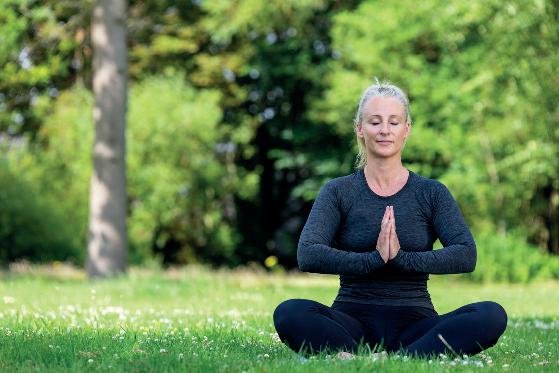
AS WOMEN TRANSITION INTO MENOPAUSE, THE CHANGES OCCURRING IN THE BODY CAN OFTEN FEEL OVERWHELMINGINCORPORATING DIFFERENT FORMS OF EXERCISE WILL PROVIDE COMPREHENSIVE HEALTH BENEFITS
Hormonal shifts, hot flashes, mood swings, weight gain, and a host of other symptoms come with this new stage of life. While these changes are completely natural, they can impact both your physical and emotional well-being. Thankfully, there’s a powerful tool to help you navigate menopause: exercise, specifically strength training.
Exercise is often touted as a remedy for many health issues, but when it comes to menopause, its benefits are even more profound. From mitigating menopausal symptoms to reducing the risk of longterm health conditions, regular physical activity can make a world of difference. Here are 7 reasons why it’s time to lace up those trainers and embrace the weight room as you enter this new phase.
result? You’ll feel stronger, leaner, and more energised.
2. Support Bone Health and Reduce Osteoporosis Risk
Regular physical activity helps regulate your circadian rhythm, making it easier to fall asleep and stay asleep
1. Combat Weight Gain and Improve Body Composition
As oestrogen levels drop during menopause, many women notice a gradual increase in body fat, particularly around the abdomen. This is not only frustrating but can also increase the risk of heart disease and type 2 diabetes. Exercise, especially strength training, helps counteract this by boosting your metabolism.
Muscle tissue burns more calories at rest than fat tissue, so the more muscle you build, the higher your resting metabolic rate becomes. Strength training helps you maintain and even build muscle mass, which is crucial for combating the natural muscle loss that comes with ageing. The
One of the major concerns during menopause is the increased risk of osteoporosis. Oestrogen plays a vital role in maintaining bone density, and as its levels decline, bones can become more fragile. This makes menopausal women more susceptible to fractures and breaks. Strength training is one of the most effective ways to support bone health. When you lift weights, your muscles pull on your bones, stimulating bone growth and increasing bone density. Weightbearing exercises like walking, jogging, and dancing also contribute to stronger bones. Regular strength training can significantly lower your risk of osteoporosis and protect your skeletal system well into your later years.
3. Boost Mood and Manage Stress
Menopause often comes with emotional ups and downs. Fluctuating hormone levels can lead to mood swings, anxiety, and even depression. Exercise, particularly aerobic activities like walking, swimming, or cycling, is known to be a powerful mood enhancer.
When you exercise, your body releases endorphins, the ‘feel-good’ hormones that reduce stress, anxiety, and depression. It’s like a natural antidepressant. Strength training also helps improve confidence
and body image, both of which can take a hit during menopause.
A regular workout routine can act as a mental reset, helping you feel more in control, balanced, and centred.
4. Improve Sleep Quality
Many women going through menopause struggle with sleep disturbances, often caused by night sweats, hot flashes, and hormonal changes. Poor sleep can affect your energy levels, mood, and overall quality of life.
Exercise is known to enhance sleep quality. Regular physical activity helps regulate your circadian rhythm, making it easier to fall asleep and stay asleep. Strength training, in particular, has been shown to improve sleep patterns in women. While exercising too close to bedtime can sometimes be stimulating, working out earlier in the day can contribute to a more restful night.
5. Manage Menopausal Symptoms
Beyond mood swings and sleep issues, other menopausal symptoms like hot flashes, joint pain, and fatigue can significantly affect your daily life. Regular exercise helps reduce the severity of these symptoms.
Cardio exercises like brisk walking, swimming, or cycling improve cardiovascular health and circulation, which can help lessen the frequency and intensity of hot flashes. Strength training also improves joint stability, reducing aches and pains associated with ageing and menopause. Plus, the boost in energy that comes from regular movement helps



fight the fatigue that so often accompanies this transition.
6. Reduce the Risk of Chronic Conditions
Menopause brings a heightened risk for certain chronic conditions, including heart disease, type 2 diabetes, and high blood pressure. This is partly due to hormonal changes but also to lifestyle factors that may shift during this time.
Exercise is a powerful preventive tool for many chronic conditions.
vibrant and youthful despite the changes happening inside.
Strength training, in particular, empowers you to feel strong, capable, and confident. It helps maintain functional strength, allowing you to continue doing the activities you love, whether that’s gardening, travelling, or playing with your grandchildren.
It’s never too late to start reaping the benefits of physical activity
Cardiovascular exercises improve heart health by lowering blood pressure, improving cholesterol levels, and increasing overall endurance. Strength training helps manage blood sugar levels, reducing the risk of type 2 diabetes. Both forms of exercise contribute to a healthier cardiovascular system, reducing the risk of heart disease.
7. Increase Longevity and Quality of Life
At the end of the day, exercise during menopause is about more than just managing symptoms and reducing risks, it’s about enhancing your overall quality of life. Regular physical activity helps you maintain independence, mobility, and strength as you age. It keeps your body functioning optimally, helping you feel
Getting Started: Simple Tips for Incorporating Exercise and Strength Training
If you’re new to exercise or haven’t been active in a while, don’t worry. It’s never too late to start reaping the benefits of physical activity. Here are a few tips to get you started:
Start small: If you’re new to exercise, begin with just 10 - 15 minutes a day. As you build strength and endurance, gradually increase the time and intensity.
Incorporate strength training: Aim to do strength-training exercises two to three times a week. You can start with bodyweight exercises like squats, lunges, and push-ups, then gradually add light dumbbells or resistance bands.
Mix it up: A balanced fitness routine includes both cardiovascular and strength training exercises. Try to do cardio 3 - 5 times a week and strength training 2 - 3 times a week.

By Saski Ford
Saski is the owner of Saski Ford Massage Therapy. Specialising in deep tissue and sports massage, providing pain relief from muscle tension and stress from every day life. Saski is also an experienced personal trainer, specialising in fat loss for women
www.saskiford.com
Listen to your body: Pay attention to how your body feels, and don’t overdo it. Recovery is just as important as exercise, so make sure to rest when needed.
Embrace Movement as a Form of Self-Care
Menopause marks a powerful transition in a woman’s life. While the physical changes can be challenging, it’s important to see this time as an opportunity to prioritise your health and well-being. Exercise, particularly strength training, is a form of self-care that can help you thrive during menopause and beyond. By staying active, you’ll not only manage the symptoms but also cultivate strength, resilience, and a renewed sense of vitality.
So, grab those weights, step outside for a walk, or roll out your yoga mat. Your body, and mind, will thank you for it!

IN TODAY’S FAST-PACED WORLD, TAKING TIME TO NURTURE YOURSELF IS MORE IMPORTANT THAN EVER
“Self-care is not a luxury, it is a necessity!”
I tell my clients this so often, especially when they tend to find it hard to look after their own needs and instead put others first. Their kids, their parents, their partners, and their friends have first dibs on their attention and energy. We all know how important it is to do what is right for ourselves, and we have bursts of essential self-care every now and then when we reach a low point. We might start eating a bit healthier, going to bed on time, perhaps even having a nice haircut or manicure… but then we fall back into our old patterns and once again we start to ignore our own needs, wants, and even boundaries. A common misconception is that self-care takes time away from our already busy life or that it costs money that we can’t possibly assign to this act of selfishness. But self-care doesn’t need to cost time or money, it can be found or created in
More often than not we are aware of what is good for us, we just don’t put it into practice
everyday activities and routines. Self-care is anything but selfish. With a healthy level of self-care, by focusing a little bit more on our own wellbeing, then not only do we feel more content and confident, we also become better parents, better friends, better partners, and better lovers. Selfcare creates a ripple effect and everybody benefits from our improved overall health, headspace, boundaries, and contentment.
Here are six kinds of self-care. These all help us to cultivate awareness of what we do, how we do it, and why. Just remind yourself, “I am doing this for me” and this will already make a difference to how you feel.
1. Physical self-care
Our diet, exercise, quality of sleep, use of substances, and personal hygiene fall under physical self-care. More often than not we are aware of what is good for us, we just don’t put it into practice. So if you are cooking a meal anyway, you might as well


Originally from Belgium, Rafaël has run private practices in the UK and France, working with individuals or couples on a huge range of issues
rafael@a-therapy.com t. 07 83 23 77 23 Advert on page 30
prepare something healthy. Give your body what it needs instead of what it wants. Healthy can be very tasty too! You can walk to the shop instead of driving, go to the gym, or have a swim once a week instead of watching TV. You can cut back on alcohol, tobacco, and sugar, and you can take good care of that wonderful body of yours. We’re going to eat, drink, move, shower, and sleep anyway and just by changing things up a bit, all these everyday activities can become acts of selfcare. By saying, “I am preparing this healthy meal for me, this walk is self-care, brushing my teeth is not just a habit but an active choice to stay healthy….” Reminding yourself of these things encourages you to feel more positive.
2. Mental self-care
Our mental health is very precious and can so easily be affected by the people around us or our circumstances. But in actual fact, it’s not the people or the circumstances that determine how we feel, it is our response to them. Mental selfcare includes setting healthy boundaries. Without them we get taken for granted, we don’t feel seen, heard or validated, sometimes we don’t even get acknowledged. That’s when resentment kicks in and we get upset or disappointed with the world around us. When we do put boundaries in place people start paying attention, we get treated more fairly, we have a voice and feel more included and valued. If nothing else, we at least value ourselves! Think for a moment how certain activities or relationships impact your mental health positively or in a negative way and make good choices accordingly.
3. Emotional self-care
We so often ignore how we feel and have all sorts of excuses and reasons not to act on our feelings
Every emotion you experience is there for a reason. Your body is trying to tell you something. Emotional self-care is about being more mindful of your emotions, paying attention to them and allowing them to be present without judgement or being ignored. We so often ignore how we feel and have all sorts of excuses and reasons not to act on our feelings, and if we do that often enough we start feeling numb. Numb can be easier in the short term, but in the long term it leads to feeling chronically discontent and sometimes even to depression. So pay attention to your emotions, give them a little more time and space, try to figure out what exactly it is that you are feeling and then you can make a conscious decision whether you will act on that emotion or whether you will just let it exist.
Now we are going to pay attention to all of our senses, one by one. Treat your taste buds by eating something purely for its taste, just a tiny piece of Belgian chocolate for instance, let it rest on your tongue and savour it for as long as you can. Listen to your favourite music, the rain, children's voices or even silence with intent. Just because it is beautiful. Take a second to smell your coffee, carefully prepared food or even freshly washed linen, the flowers in your garden or your shower gel, and let it linger for a few seconds. Wear a scent that makes you feel good. Look at clouds, nature, your loved ones, a pretty pattern or your favourite car… just because you can and you like how your vision can make you marvel. And feel, not just with your hands but with your entire body. Feel how the warm water runs off your neck in the shower, how soft your new jumper feels on your bare skin, how someone’s touch feels on your arm, how warm your cup of tea feels in your hands and how fluffy the cat feels when you stroke it. Be mindful and allow your senses to delight you.
5. Spiritual self-care
Feeling connected to something bigger than our immediate context can be a spiritual experience. For some it can be praying and spending time in church, mosque or temple and gathering with people of their faith. For others it can be meditation, going for a long run, paying close attention to the miracles of nature, it can be getting lost in art or music, or even as simple as looking at the ocean or staring in a fire. Even if it is just a few minutes a day. I haven’t come across somebody who looked at the stars for a few minutes and said, “That’s a bit shit isn’t it”. No, we feel in awe when we pay
close attention to what surrounds us. Whether it is our god, our core community, nature or the universe. It makes us feel good.
6. Adventurous self-care
This is about pushing your boundaries and getting out of your comfort zone. For some people it can be skydiving, bungee jumping or rock climbing, but it can also be a lot less scary than that. Order a spicy dish when you normally order mild food, try a drink you haven’t had before, go to a place you have never been to, listen to music you don’t know just yet, run an extra mile or cook a more complicated meal following a recipe, try a new skill or learn a language… whatever goal you set for yourself, when you achieve it you will experience that warm feeling of success. It lifts you up and feeds in to your sense of self worth.
When you intentionally pay attention to the almost unlimited acts of self-care as explained here, every single time your brain will produce a small or - depending on the activity - large dopamine or serotonin hit, and that makes you feel good, content or even happy. What’s not to like? And it doesn’t take that much effort or time. Just create more awareness and be more mindful of your everyday habits, routines, and actions.
To get started, pick one area of self-care to focus on per day and as time goes by you will notice that it comes to you more naturally and all the six areas will start to merge into each other creating overlap. For instance, having a very hot or cold shower can be physical, sensual, and adventurous self-care all at once. It takes time to form new habits so making a plan could be helpful, write down what changes you can already make or what you could pay more attention to. And remember, actively practising self-care is not being selfish, it is what you deserve and need to feel content.













OCTOBER CAN OFTEN STILL FEEL LIKE SUMMER IN THIS PART OF THE WORLD AND WE USUALLY HAVE PLENTY OF LOVELY DAYS TO ENJOY BEING OUTDOORS RIGHT UP UNTIL EARLY NOVEMBER
Often the garden is looking a bit tired and lacking colour as many of the summer flowering plants have gone over but there are still lots of really lateflowering plants that we can use to extend the season of colour, scent, and nectar for butterflies and bees which are still active and busy storing up supplies for the winter.
The first two plants are autumn flowering bulbs, both are very hardy and will spread naturally in the border. Hesperantha
coccinea (formally known as Schizostylis coccinea) is a member of the lily family and produces spikes of deep pink/red flowers over a long period from late September. The foliage is semi-evergreen, and they will form a nice clump over a couple of years. They look great planted alongside Nerine bowdenii – although these start to flower slightly later producing impressive flower heads on bare stems, the leaves grow after flowering.


Le jardin créatif
Caroline has been a lecturer in horticulture for 20 years and now runs a nursery and ‘garden craft’ courses in the Haute-Vienne at Le jardin créatif
Many of the summer flowering plants have gone over
Late-flowering herbaceous perennials include the hardy Chrysanthemum and the Asters, both members of the daisy family producing masses of flowers from September through to the end of October. One of the loveliest is Chrysanthemum ‘Cottage Bronze’ which has coppery orange large daisy flowers which complement the golds and reds of the autumn leaves which start to turn at the same time, and also Aster ‘Blue
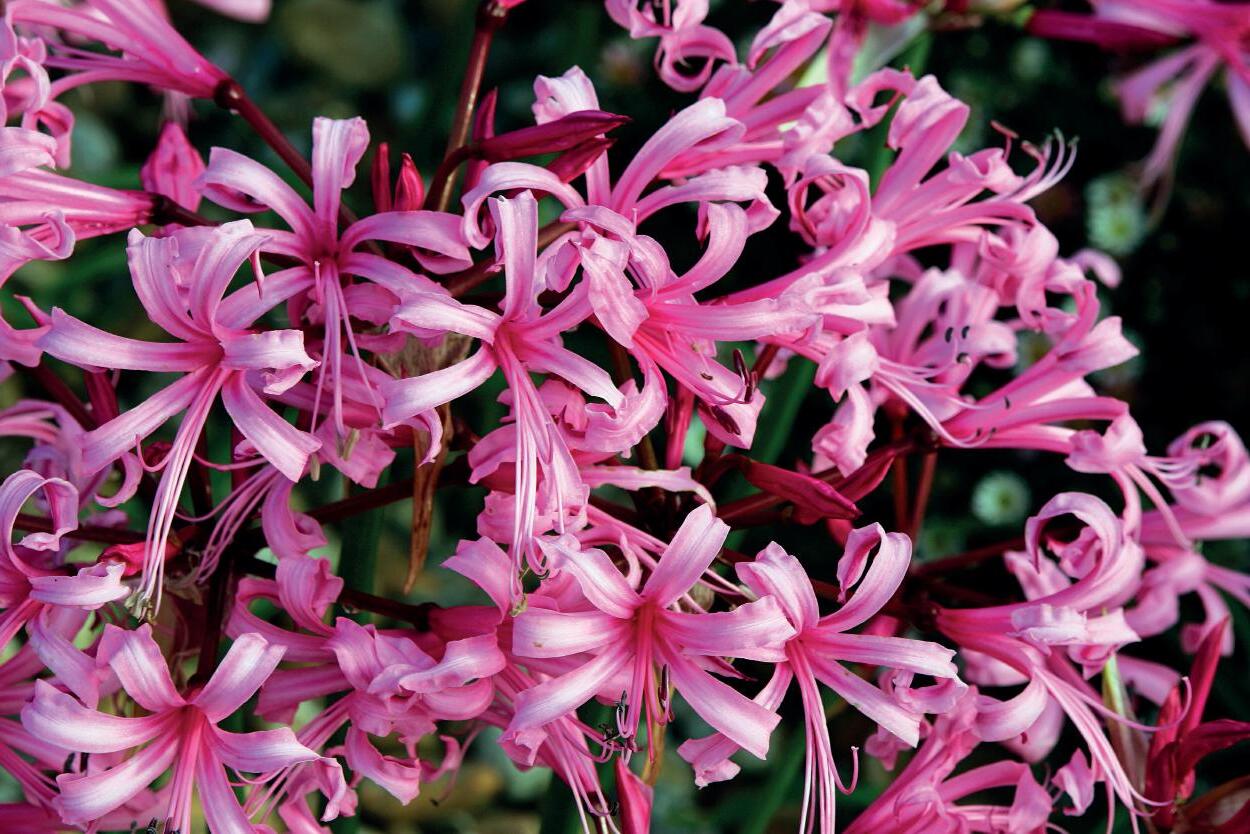


Heaven’ with masses of long-lasting skyblue flowers that complement the autumn colours. I find that giving all of these daisies the ‘Chelsea Chop’ – i.e. cutting the young stems about halfway back around the time of the Chelsea flower show (late May) - triggers the production of more side shoots and therefore more flowers later on as they are produced in clusters at the end of each stem.
One of my favourite late-flowering plants is Epilobium ‘Western Hills’. This plant is actually a willow herb, but it does not produce the masses of airborne seeds like the tall, herbaceous ‘rosebay willow herb’ (which is still a beautiful plant) – but it is a fairly lowgrowing sub shrub that produces masses of tubular red flowers from mid-August right up until the first frosts. Although it produces woody stems at the base, I treat it like a herbaceous perennial and cut it down to ground level with all my other herbaceous perennials in late winter. It produces numerous more new stems from below the ground in early spring and spreads nicely along the front of the border for a long-lasting display. It is very drought tolerant and does well in poor
soils, and it is also suitable for a rock garden.
Many of the summer flowering plants have gone over
Another favourite is Ceratostigme willmottianum, also a sub shrub that I treat like a herbaceous perennial. It begins to produce its deep sky-blue flowers around the end of August and continues flowering until the first frosts. It makes a good companion to the Epilobium, as the colours complement each other nicely and it is slightly taller so it can be planted just behind it. They both enjoy the same soil conditions. As the nights get cooler the foliage starts to produce its stunning red autumn colour, and this also adds a nice bit of contrast to the blue of the flowers.
Of course, I can’t talk about long-lasting colour without mentioning the Salvias. The shrubby Salvia varieties such as ‘Royal Bumble’ and ‘Nachtvlinder’ flower from April to November and even into December with a constant display of colour, but there are some herbaceous Salvia that only start coming into flower in the late summer/early autumn and their flowers are generally very showy. Many of them are fairly tall and therefore give

the winter so I plant mine against the wall of the house where they benefit from the radiant heat retained by the stone wall and are protected from extreme wet because they are under the eaves. Salvia mexicana, Salvia leucantha, and Salvia curviflora are superb examples.
As we move on into the deeper winter months, we have to look for colour in leaves and bark but there are still flowers to be found. The other benefit of winterflowering plants is that they tend to be heavily scented - this is so that they attract pollinating insects from a wide radius when they emerge from hibernation on winter days in search of nectar. Three of the best are:
Lonicera x fragrantissima – a deciduous shrub that flowers on bare stems and as the name suggests is highly fragrant, begins to flower from late December and continues through until April. One twig bought indoors will fragrance a room and it is well loved by the bees as well as flower arrangers.
Sarcococca confusa – also known as the ‘Christmas box’ is an evergreen shrub with deep green shiny leaves (a little similar to a ‘box’ plant) and masses of highly-scented flowers from around Christmas time. It is also good as hedging if you have had trouble with box blight although it doesn’t respond as well to being clipped because you will lose some of the flowers.
Lastly Skimmia japonica ‘Rubella’ produces flower buds in the late autumn but sits with them tightly closed all winter. These tiny red buds are attractive in their own right (hence the cultivar name ‘Rubella’). When they open in late winter they produce masses of scented white flowers. Both the Sarcococca and the Skimmia are suitable for growing in containers and prefer a little shade.

Our nursery and garden are still open every Saturday from 10h00-16h00 until the end of October. Our plant list is online, and you can still order plants for collection or delivery during the winter months.
Check out the website for our schedule of courses and workshops throughout the autumn: lejardincreatif.net
Follow us on Facebook to get notifications of our courses and events: @LeJardinCreatif87























THIS MONTH THE BIGGEST CHANGE WILL BE THE MUCH SHORTER LENGTH OF DAYLIGHT HOURS; WINTER IS ON ITS WAY!
It is time to plan for the winter by protecting both delicate summer blooms from winter chills and frosts, and vacant soil from the winter rain.
Once flowering is over and before the first cold weather is the time to dig up some summer bulbs such as dahlias, cannas, and tuberous begonias which are not hardy, and store them in the best conditions for next spring. It is possible to leave these bulbs in the ground over the winter, but if you are in an area that can experience heavy winter frost, or if you have heavy soil which retains moisture in winter, they will not be able to spend the winter in the ground. But even in the mildest regions it is safer to lift the bulbs to prevent them rotting. Lifting the plants at this time of year also allows you to relocate plants easily and get earlier flowers by starting their growth early next year in a warmer environment – a greenhouse or frame. It is best to leave the bulbs in the ground until after the first heavy frost when the leaves will be burnt and turn black. This ensures the storage of nutrients in the bulbs. Once the leaves have wilted and turned black, and before the cold and wet weather sets in, it is time to dig up the summer bulbs.
Lift the bulbs in dry weather, if possible after several days without rain, using a garden fork to pry up the bulbs without damaging them in any way. Remove as
much soil as possible and cut the wilted leaves 2 cm above the bulb with sharp pruning shears. Place bulbs, well spaced, on a bench lined with newspaper to let them dry thoroughly, somewhere sheltered from the rain. After a few days gently remove the remaining soil without injuring the bulbs, as each of the wounds would be the gateway to many fungal diseases. Detach any bulbils and store them for future planting in individual pots, remove bulbs with spots or signs of rot and leave in a sheltered, cool, shaded, frost-free place for another couple of weeks to finish drying. Once they are completely dry put the bulbs in sawdust or dry sand in a box, or nylon stockings, kraft paper bags or onion nets. Over the winter store the bulbs in a dark, dry, and wellventilated place where the temperature will be maintained between 10°C and 12°C.


ByRonnieOgier
Ronnie is a passionate gardener and now loves sharing her years of experience of success and failures in her own garden and sharing it with you. Also a keen runner, having been bitten by the ‘Couch to 5K’ bug!
contributes to a natural gathering of organic matter. The green manure can be used between two cultivations of a plot at almost any time of the year, but I think it is most useful during the autumn, when you sow fodder or legume seeds which can be cut back and either turned in or left on the ground surface to feed the soil during the winter.
Green manure preserves and improves the structure of the soil
To protect and improve the soil which is empty either from lifting plants or when your vegetable harvest is completed, it’s not too late to plant green manures. Green manure preserves and improves the structure of the soil, provides fertilising elements, and prevents the emergence of weeds. It consists of sowing fodder plants or legumes in empty areas of the garden. The manure will be buried in the ground after flowering. The dense foliage, once buried in the soil, ferments quickly, and
The advantage of growing green manure is that it fixes nitrogen in the soil and improves drainage while the root network of the manure plants helps to retain soil in place by limiting erosion caused by winter winds and rain. The structure of the soil is thus improved at the physical, chemical, and biological levels. The other advantage of green manure is to prevent weeds from invading the plot. Sowing is usually done in the autumn after a harvest or in the spring before the first plantings.
There is a range of plants which can be used as green manure. The choice depends on the nature of the soil and the needs of the crops to follow on. Generally, the most common sowing is carried out with legume fodder plants such as clover, alfalfa, vetch, or non-legume plants such as mustard or phacelia. Other plants such as rapeseed, buckwheat, rye, cabbage or rye grass can also be used.


The choice of green manure to sow depends on the soil. Yellow mustard, which grows quickly, is well known for its natural insecticidal action. Phacelia is also a naturally effective insecticide as well as an excellent nitrate fixative, because of its dense and fine root network that suffocates weeds. The forage rape is very rich in nitrogen but its powerful roots make it difficult to bury. Ryegrass (Italian or English) is ideal for fallow land since it protects the soil from leaching, but on the other hand it attracts harmful insects. Clover (purple or crimson) is perfectly complementary to cruciferous crops (cabbage, turnips, rapeseed, etc.) since it is rich in nitrogen.
The different types of green manure
Green manures with nodules in the root system
These swollen parts contain bacteria that can capture atmospheric nitrogen and transform it to make it available in the soil and in the plant's tissues. Fabaceae (legumes) such as lupin, alfalfa, vetch, peas, fava beans or clover have this ability. These green manures can be used to enrich the soil with nitrogen, structure it and cover it. They will be ideal before growing leafy vegetables as part of the crop rotation in the vegetable garden.
Green manures with a dense and deep root system
This property allows them to draw mineral nutrients from deep down and make them available on the surface as they
decompose. These plants structure the soil, allow better penetration of water and air, and decontaminate the land. Mustard, buckwheat, rye, phacelia, and oats are among them. Some of these plants provide a very good amount of carbon once buried. If you plan to use green manure during the growing season between two crops, you will need to choose one that grows quickly. White mustard is perhaps the fastest grower, followed by phacelia, buckwheat, fava beans, vetch, and oats. Rye, red clover or lupin take longer to grow to maturity and so could be used to cover the ground for a longer period of time. However, if you want to stop the spread of unwanted weeds, opt for phacelia, mustard, alfalfa, buckwheat or rye.
matter. These dead leaves still contain it (lignin) and when it decomposes, the lignin does not release CO2, but fixes it in the soil as it decomposes and becomes humus. In autumn, dead leaves accumulate and usually create a few holes in the lawn if left or make a path slippery, which is why it is better to pick them up if they get in the way.
This mixture of lawn and semi-crushed leaves is transformed into light and rich soil
Green manures have other benefits. In areas with heavy winter frosts, fava beans, alfalfa, red clover, or rye will survive the cold. To attract pollinating insects, choose alfalfa, clover, mustard, and phacelia; to prevent nutrient leaching and soil erosion, use red clover or vetch; or if you are looking for a green manure that provides a good carbon supply after burial, consider grasses such as oats, rye, or buckwheat, which is part of the polygonaceae family. But also remember that fallen leaves are really a gift for the gardener! Keeping your dead leaves is good for the garden! The tree took nutrients from the soil and CO2 from the atmosphere to make this organic
The leaves on the lawn can be collected by mowing. All the more so since now, with the very mild autumn temperatures, the grass continues to grow happily and it must be mowed until the end of autumn. This mixture of lawn and semi-crushed leaves is transformed into light and rich soil: the leaves provide the lignin which makes it light and draining, the lawn provides nitrogen, the nourishing element. You can simply place what comes out of the mower bin around rose bushes and perennials or on the vegetable garden, in a thick layer of 15/20 cm. This will settle quickly (within a week) and will be gone by the end of the winter, while improving the soil. The weight of the damp grass prevents the leaves from flying away. In addition, as the leaves decompose, they feed and maintain many bacteria, fungi and small animals (springtails and earthworms, among others), which are essential for the balance of the soil.
Plenty to do during October!




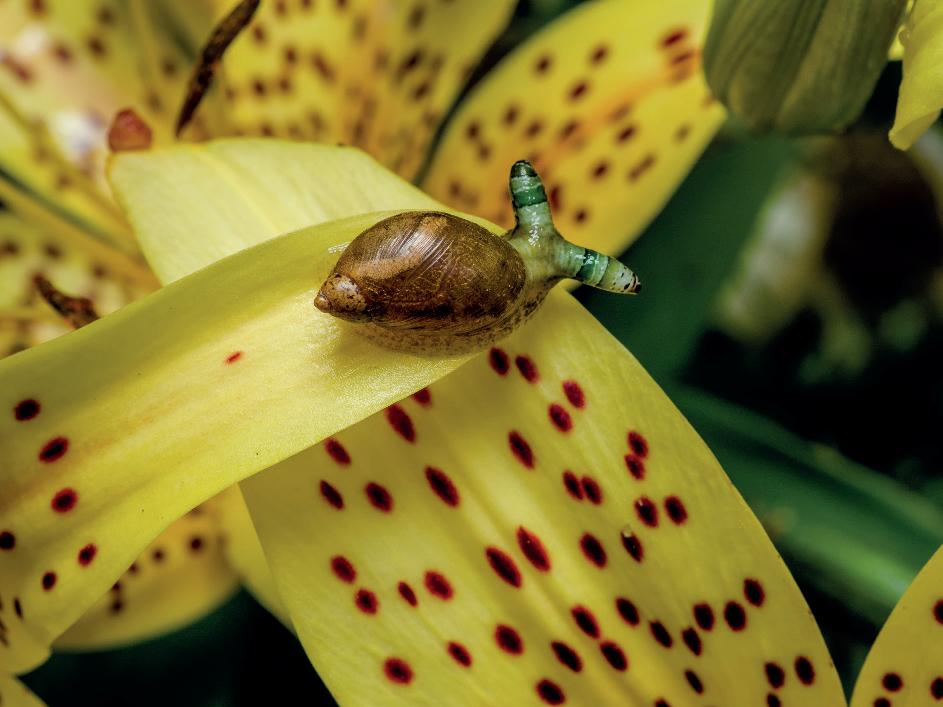





IT’S NEARLY HALLOWEEN, SO IT’S TIME TO GET A LITTLE GRUESOME… I SUGGEST NOT EATING WHILE READING THIS!

ByMikeGeorge
Mike George is our regular contributor on wildlife and the countryside in France. He is a geologist and naturalist, living in the Jurassic area of the Charente
One character that everybody likes to remember at Halloween is Dracula. Not many have read the book, but we’ve all seen the films. Now, is he a predator or a parasite on other humans? In point of fact, even he doesn’t seem to know. Remember, a predator kills and eats what he needs to give him strength, while a parasite feeds from its host, and usually manages to complete several lifecycles, breeding and reproducing while drawing its sustenance at the expense of the host. Eventually, of course, the host will die, but that is in the nature of things; the parasite has succeeded in making good use of its supplier! In fact, it has been said that a

parasite is a predator that consumes less than one victim.
What Does Dracula Do?
He must consume blood to continue his existence. In this he is an external parasite, as he tends to have few victims and certainly doesn’t live within them.
Some of the victims may have their existence altered and become vampires themselves, and this is decided by Dracula
Eventually, the victims, who become controlled by him, will die. Some of the victims may have their existence altered and become vampires themselves, and this is decided by Dracula. Other people may work for him or associate with him and do not become parasitised. All this fits in with the behaviour of parasites in nature.
However, because most of Dracula’s victims eventually die, either because Dracula over-feeds or because others realise that the victim is beyond help and must be killed to take them out of Dracula’s hold (stake through the heart, silver bullet, etc), Dracula could be said to be responsible for the death of his hosts and therefore is strictly a parasitoid, a form of parasite that uses its living victim for short-term sustenance but as a result causes its death. These are exemplified by several wasps, such as the Ichneumonid wasps that lay their eggs in caterpillars, or the spider wasps that paralyse and entomb spiders to feed their growing young.
Parasites are widespread and common in nature. I am sure that you are familiar with many, or at least will have heard of them. Your pets are martyrs to them.





In the blood stream, further reproduction occurs within red blood cells


Parasite reproduction results in further red blood cell infection

Ectoparasites such as fleas and ticks, endoparasites such as roundworms and tapeworms, all of which can introduce infections into the host’s body and which draw out energy and weaken the host, either by the act of stealing its nutriment or by annoying it in some way as their offspring try to leave the host’s body. Very unpleasant, and all needing to be treated and eliminated.
Malaria Is a Parasite
There are many parasites that prey on humans if they get the chance. Some of these are very nasty, such as malaria, which is a single-celled Plasmodium organism introduced to the body by a vector insect, a mosquito. Once the Plasmodium cells enter the body they multiply in the bloodstream and end up in the liver. Here they begin to make themselves felt by inducing fever, especially recurring paroxysmic fevers every two days (tertian fever) or three days (quartan fever) depending upon the malarial strain. One other thing that the parasite does, however, is to make the body produce volatile chemicals in its sweat, which signal to mosquitoes that the person is infected. The mosquitoes are drawn to these odours and their chance of collecting infected blood is increased,


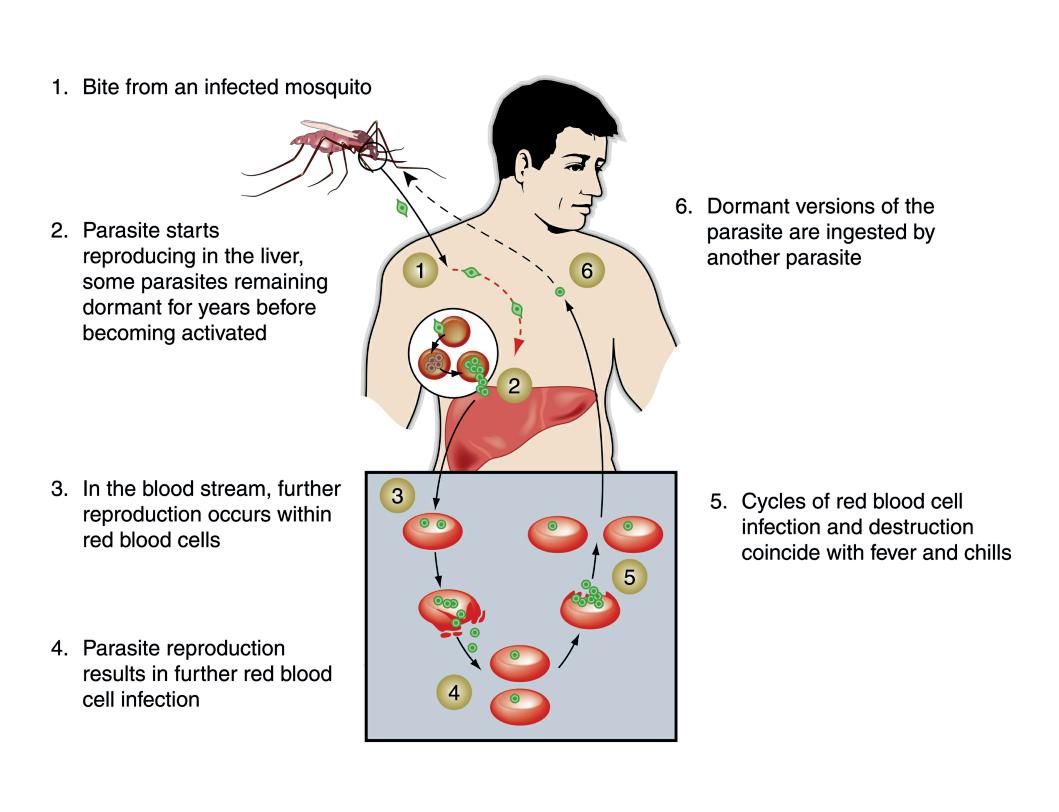
multiplying the parasite’s chance of spreading.
This fascinated me, and I decided to look for other examples of parasites that altered their host’s activities or behaviour to the parasite’s benefit. The more I looked, the more I found.
Ant surrounded with tentacles by the invading Cordiceps fungus to deter secondary predation

Dormant versions of the parasite are ingested by another parasite



Cycles of red blood cell infection and destruction coincide with fever and chills

The Zombie Ant
There is a type of Carpenter Ant Camponotus leonardi that lives in tropical forests. Its preferred habitat is high in the forest canopy, but from time to time, in order to move about the forest, it must descend to the forest floor. Here it is in





danger of gaining the spores of a particular fungus Ophiocordyceps unilateralis upon its body, which break through the ant’s tough exoskeleton by enzyme activity and pressure. Once inside the ant, the cells spread and begin exuding chemicals that will interfere with the function of the ant’s brain.
The snail’s behaviour is altered so that it goes out in the sunlight and stays out of cover longer
First, the ant will convulse to the extent that it falls from its nest to the forest floor. Here it will be induced to climb a plant to a height of about 68 cm, then lock its jaws with extreme strength onto the surface of a leaf. This will result in the ant hanging upside down below the leaf. This is known as ‘the zombie death-grip’. At about this point the ant dies, and the fungus develops towards maturity, putting out protective tendrils and chemicals from the ant’s body to deter outside predators. Finally, the fungus will send out from behind the ant’s head a strong but flexible stem on which the fungal spore body grows, which will allow the spores to develop and to be released and start another cycle. The ant’s body remains on the leaf. As you can deduce from the activity of the affected ant, this all takes place near a suitable ant colony. The area is a graveyard of dead ants, and the chances of the fungus finding a new host is multiplied.
However, there is a fungus anti-parasite, another fungus, which will attack the zombie fungus and prevent it creating its spore body, which reduces the chance of infection.
You can read more at: en.wikipedia.org/wiki/ Ophiocordyceps_unilateralis
Now, I know a fungus seems like cheating. It’s not an animal, so how can it be a parasite? Well, it isn’t the only parasitic fungus. We all know the Honey Fungus Armillaria mellea, which is able to parasitise trees and has even grown into the largest living organism on Earth, covering many acres of woodland. Other fungi also parasitise insects, and a few of the Candida species even manage to parasitise humans, but without the same controlling results – as far as we know.
The Green-banded Broodsac
This is the rather odd name for a worm, a platyhelminth scientifically named Leucochloridium paradoxum. This is a parasite on a land snail, Succinea putris, which lives in northern Europe, even in the UK, and the parasite operates throughout its range.
This parasite is a parasite in several ways. It feeds off its host, and if all goes to plan it escapes from its host on a regular basis, but it is just as likely to kill its host. The trouble is, the parasite, being a worm, prefers to reproduce sexually, and it can’t do this in the snail. It can only reproduce there asexually, and this is not a good strategy for an animal. The parasite can only reproduce sexually in, of all places, a bird’s backside!

The worm’s eggs fall in bird droppings onto leaves, on which the snail feeds. Once the snail has ingested the eggs, they hatch, and the resulting organism makes its way to the snail’s liver, where it can begin to tap into the snail’s food supply. Then something horrifying but amazing takes

place. The worm starts to grow, and pushes up strange brood chambers on long stalks. These enter the snail’s antennae (or eyestalks, to be more precise) and fill them. The brood chambers are striped green and brown, and pulsate actively. In fact, from a distance they look like a caterpillar crawling across a leaf. In addition, the snail’s behaviour is altered so that it goes out in the sunlight and stays out of cover longer, for greater visibility. And that is just what the worm wants. An insectivorous bird, looking down, will not see a snail but a juicy caterpillar. The worm hopes it will swoop down, grab the morsel and tear it off, swallowing it. If all goes well, the snail will have lost its eyestalks, but these will regrow to provide a site for its resident worm (which has not been harmed) to grow a new pair of worm brood pouches to attract another bird. Meanwhile the first bird now has the worm’s original brood pouches, which will release a series of worms which will pass through the bird’s digestive system (each protected by a layer of mucus) until they reach the bird’s cloaca, or rectum. Here the worms will attach themselves to the cloaca wall with suckers, and proceed to enjoy sexual union (in a wormy fashion), then produce and release eggs to fall onto new leaves and start the process all over again. Meanwhile, back at the snail, the original worm is hoping to find a new bird, again and again and again. It’s no fun being a snail!
There is another parasite that needs to control its host to enable itself to enter an environment where it can reproduce sexually, but in this case, it is a single-




celled parasite that has learned to control a vertebrate!
Toxoplasma gondii is one of a series of diseases that affects vertebrates, including humans, but it is happiest in the intestines of a cat. However, it spreads quite widely by interaction between other animals and cat droppings (which is why pregnant women should take extreme care when emptying a cat’s litter tray).
One of the species likely to be infected is mice.
Now Toxoplasma gondii is not happy in a mouse’s digestive system. To get back into another cat would be its dream (if it could dream). So, it manages to involve itself
Early research suggested that it persuaded the mouse to go out and pick a quarrel with the nearest cat
with the mouse’s brain and creates cysts there, which affect the mouse’s behaviour and make it more likely that it will fall victim to a cat. Early research suggested that it persuaded the mouse to go out and pick a quarrel with the nearest cat, but now it seems that the change is more subtle; to make the mouse more adventurous and less afraid of any predator that could kill and eat it. In our urban environment, that would probably be a cat.
Toxoplasmosis does cause illness in humans, but so far there is no indication that it tries to mess with our sense of selfpreservation. Watch this space!
Yes; I am afraid that Nature is a rough, tough place, and we can find ourselves involved in it if we are not too careful. Have a happy Halloween, and don’t have nightmares!



two does in the


AUTUMN IS THE TIME WHEN A MALE DEER'S MIND STARTS TO TURN TO THOUGHTS OF LOVE. IN OTHER WORDS, IT'S THE RUT! CUE FOR A CLOSER LOOK AT DEER…


ByMikeGeorge
Mike George is our regular contributor on wildlife and the countryside in France. He is a geologist and naturalist, living in the Jurassic area of the Charente
S
o, what is an antler? Surely, an antler is just a big horn? Well, no, it isn’t. Antlers are deciduous, that is, they fall off once a year. Now, a horn is firmly attached to an animal’s skull. There is a permanent outgrowth of bone which forms the core, and a layer of chitin (that’s the chemical name for horn, fingernails, etc) that covers it. To remove it from the animal requires a surgical procedure (think of dehorning cattle) and the horn does not grow again.
Only one group of animals has developed the antler habit, which seems to have evolved in the early Miocene period, about 19 million years ago
Only deer have antlers. These are in fact very odd structures, that form in a totally different way from horns. On two special bony platforms on the deer’s skull, called pedicles, a spongy tissue called ‘velvet’
forms, quite unlike any other type of tissue, once every year. This tissue is very well-supplied with blood, and carries the building blocks of bone, nerves, and tissue, which all clump together under some sort of shape-control to form two antlers. The rate of growth of these structures is far greater than for any structural bone. They grow larger each year, but each pair starts from scratch!
Creepily, there are analogies between the growth of antlers and the growth of cancers. The outcome, of course, is very different, but I understand that some thought is being expended on this.
Once the antlers have grown, the velvet dies. It then itches and the irritated male tries to scrape it off his new antlers. But
the material of the antler is now dead. It has no vital connection to the rest of the body, and if any part of the antler breaks or is cracked, it will not bleed or infect the animal. In that way it is analogous to hair or fur. Also, because it contains more collagen than structural bones, and grows faster, it is more flexible.
This is a terrible burden upon each animal’s metabolism. The expenditure in energy and nutritional requirements to build a set of antlers from scratch, only to have them fall off six months later, is extreme. This is probably the reason that only one group of animals has developed the antler habit, which seems to have evolved in the early Miocene period, about 19 million years ago.
One curious fact is that the antler seems to have replaced a feature of deer dentition. The ancestors of deer bore strong canine
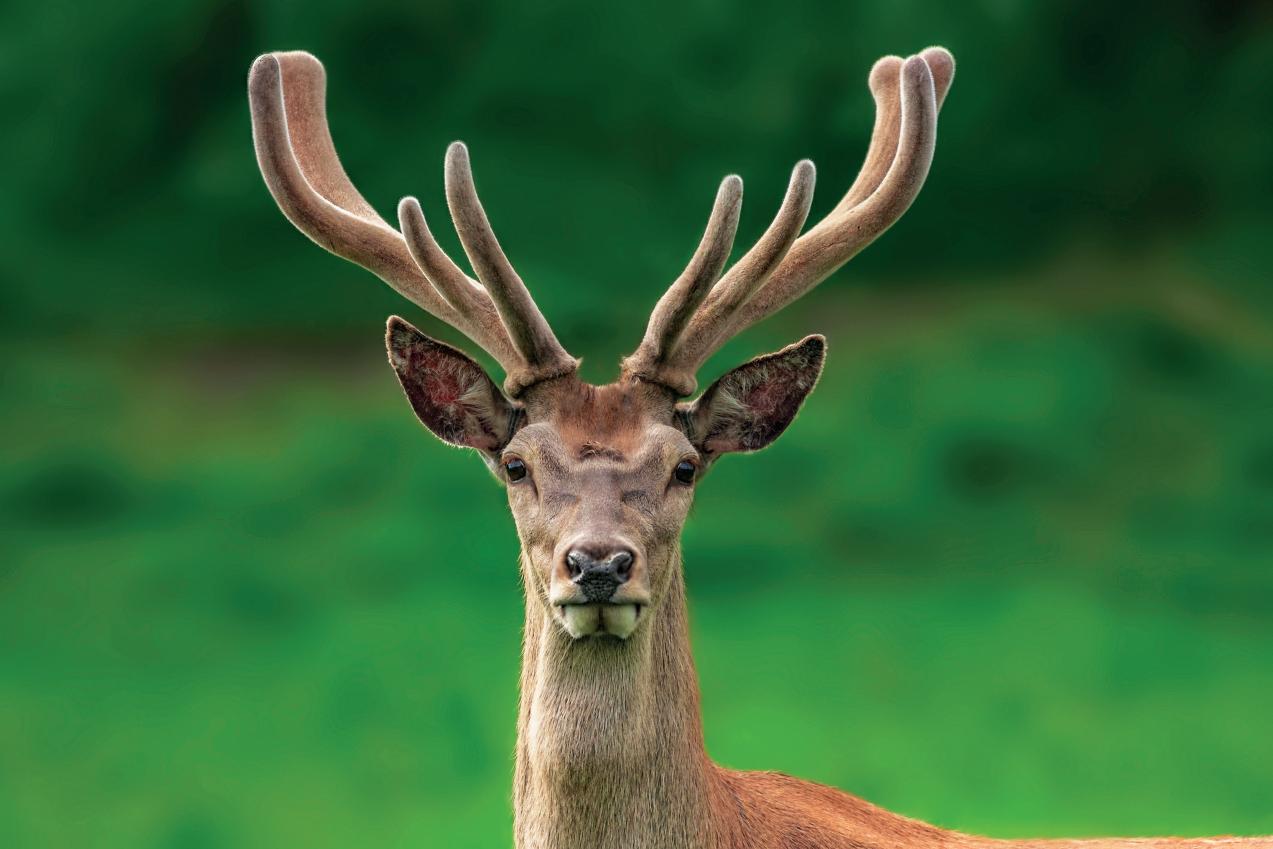

teeth down-curving from the upper jaw. Only very few modern deer have this feature: the Chinese Water Deer Hydropotes inermis (which has no antlers) and the Muntjac Muntiacus reevesi which has very tiny antlers barely a few inches long.
So What Use Is This Structure to a Deer?
Deer are a pretty successful group all told, so the antler must have some advantage in
itself for them. The answer seems to be that it suits their life and mating regimes. Also, with one exception (the Reindeer), it is only the males that have them (although a few instances are known in which females with an excess of testosterone production have been known to grow antlers). Now male deer generally try to collect a herd of compliant females that they can mate with. As we have already seen, a fine pair of antlers indicates a fit, resourceful male who can find enough

An old print of antlers of various deer species, and how they develop from year to year.
extra food to grow them well. Also, it will probably deter the advances of a lesser male whose antlers can’t match the dominant male’s. If it comes to a fight, both animals are equipped with a handy set of weapons whose main purpose is to push, not stab.
Then the Whole Thing Falls off?
The antlers normally grow in spring, and last through the ‘rut’ or mating season.
Deer are a pretty successful group all told, so the antler must have some advantage in itself for them
After this point, osteoclastic cells attack the base of the antler, which eventually falls from the deer’s head. This usually occurs at the turn of the year. In the case of the female Reindeer, who also grow antlers (albeit slightly smaller ones than the males), the antlers outlast those of their males, falling in late winter. It seems that the females, in what is a somewhat matriarchal species, defend their rights to search the snows for food during winter, and the antlers help in setting hierarchies. There was a rumour some years ago that, because of this difference in times of shedding, Santa’s Reindeer, pulling his sleigh at Christmas, must be females! In fact, young male Reindeer also drop their antlers in January, so the question, as if it mattered, is unanswered.


Of course, discarded antlers are very full of good nutrients and important chemicals for all sorts of other creatures, containing calcium, phosphorus, and a host of useful things. They are usually attacked or nibbled by a huge range of creatures, vertebrate and invertebrate, eager for bone-growth material, tissue, chitin – you name it! Of course, there is also a competitive urge in humans to find shed antlers. You get a splendid trophy to hang on your wall, without the bother, expense, and culpability of having killed an animal to get it. There are even antler-hunting dogs! Some Americans form clubs and societies
of shed-antler collectors, and have competitions with their dogs!
Discarded antlers are very full of good nutrients and important chemicals for all sorts of other creatures
In earlier days, France had several species of deer, notably the Red Deer Cervus elaptus (Fr: Cerf élaphe), the Fallow Deer Dama dama (Fr: Daim) and the Roe Deer Capreolus capreolus (Fr: Chevreuil). Now the former two are more or less confined to deer parks, but the Roe Deer is still widely seen wild in rural France, and may cause consternation by appearing suddenly before one’s car on a country road. Remember, if you see one, there are

probably others about – they tend to travel in groups – and I have seen four together hurdling a roadside hedge to the terror of unwary drivers.
It is also the cause of some excitement on a Sunday in the hunting season in France, when groups of determined-looking armed men may suddenly appear in clearings beside woodlands, or strung out along the roadside. Be very careful if you are walking your dog at such times. Wear very visible clothing, and make sure Fido is securely on his lead!
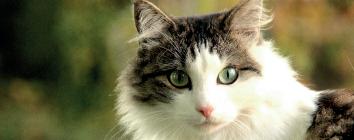





















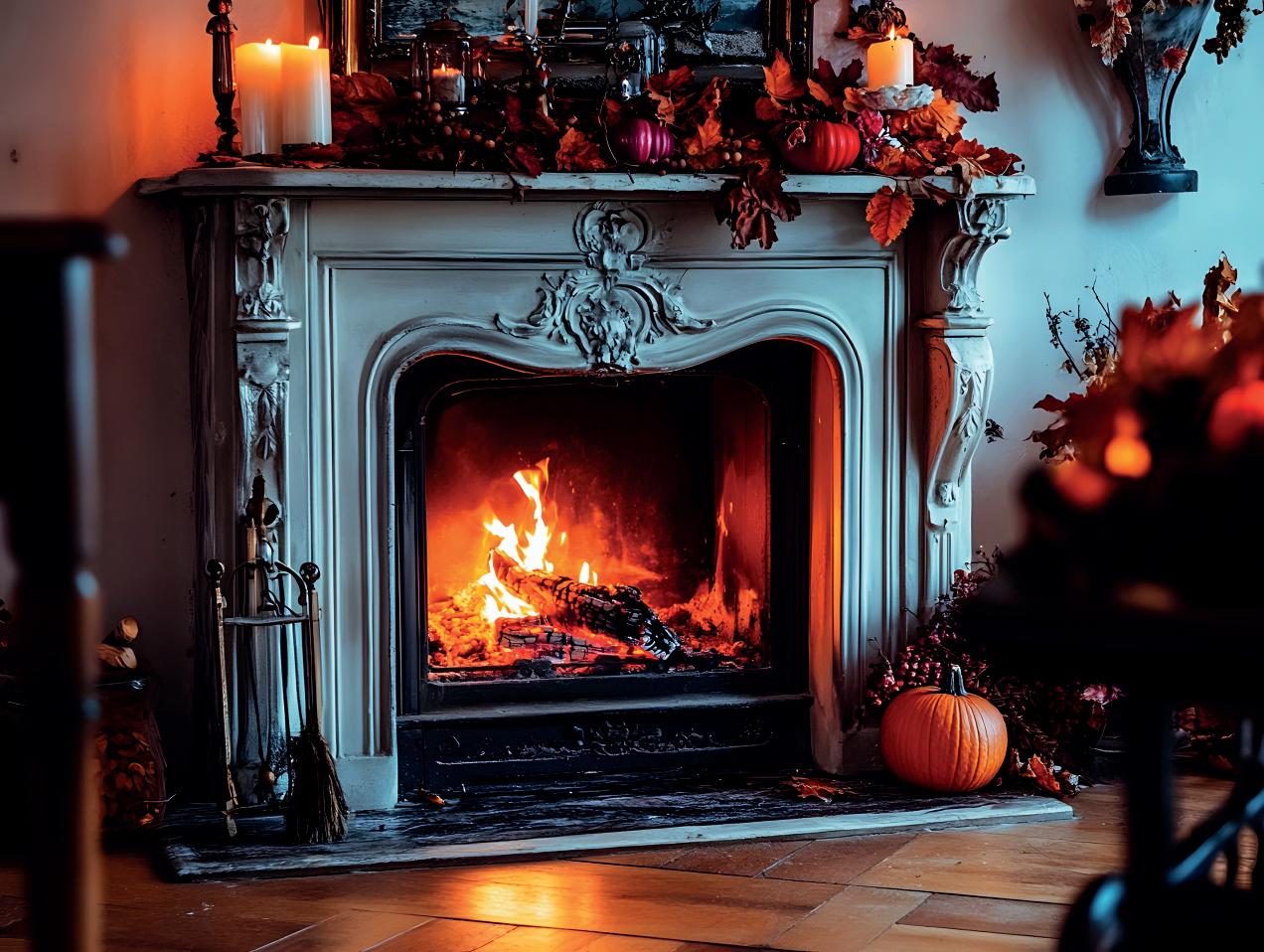
MASTER THIS FIRE LIGHTING METHOD FOR A CLEANER, EFFICIENT TECHNIQUE THAT BURNS LONGER WITH LESS SMOKE AND EFFORT
Roughly 1 million years ago, our early human ancestors, the Homo erectus, achieved a pivotal feat in the evolution of humankind: the lighting of the first fire. Since this monumental moment, fire has served as a beacon of civilisation, a source of warmth, protection, and culinary innovation. From ancient dirt hearths to modern wood-burning stoves, the quest to master the flames has been an enduring endeavour, steeped in tradition and
ingenuity. Among the myriad techniques passed down through the ages and relatively recent innovation, we have discovered what we believe to be the best method for lighting a fire.
Understanding ‘Top-Down’ Lighting
The exact origins of the ‘top-down’ method of lighting a fire are difficult to pinpoint. What we do know is that the genesis of the method is from Scandinavia, where harsh


cold winters combined with an abundance of forests and firewood necessitated efficient and effective fire-building techniques to provide warmth and sustenance for its people.
The ‘top-down’ method upends the very core of our fire lighting understanding, literally. The method involves arranging our firewood/kindling formation in the complete inverse of what our ancestors have done for the last 1,000,000 years,
placing our firewood at the bottom of our formation and laying the kindling on top. Once our firewood is placed, kindling is set in a ‘lattice’ formation (think Jenga but without the middle blocks) along the firewood and placing our firelighting cubes (or wax shavings) within the formation, then setting it ablaze.
The reasons why the top-down lighting method is so effective come down to two main reasons:
1. The ‘lattice’ formation maximises airflow through the kindling formation, allowing the oxygen, which will react with the wood gases, to cover a larger surface area, increasing the efficiency of the burn and raising the temperature of the fire much faster
2. Around 80% of the heat we can benefit from when burning wood comes from the wood gases. The gases are released as the wood heats up and naturally rises. This causes all wood to burn from the ‘top-down’. (This is also why wood-burning stoves do not need or have a grate at the base of the firebox.)
When setting a fire using the ‘traditional’ method, even if you were to use a lattice formation below the denser firewood, the flames from the kindling below cause the gases stored in the firewood to be released before there is enough heat for them to combust. This happens due to combustion requiring three elements: fuel, oxygen, and heat. Although there is plenty of fuel stored within the dense wood and plenty of oxygen supplied by the air vents of the stove (or surrounding air with an open fire), there is not yet enough heat to cause the combustion reaction (wood gases + oxygen) to occur. As a result, plenty of smoke is released from the wood and is wasted up the chimney before it has a chance to combust.
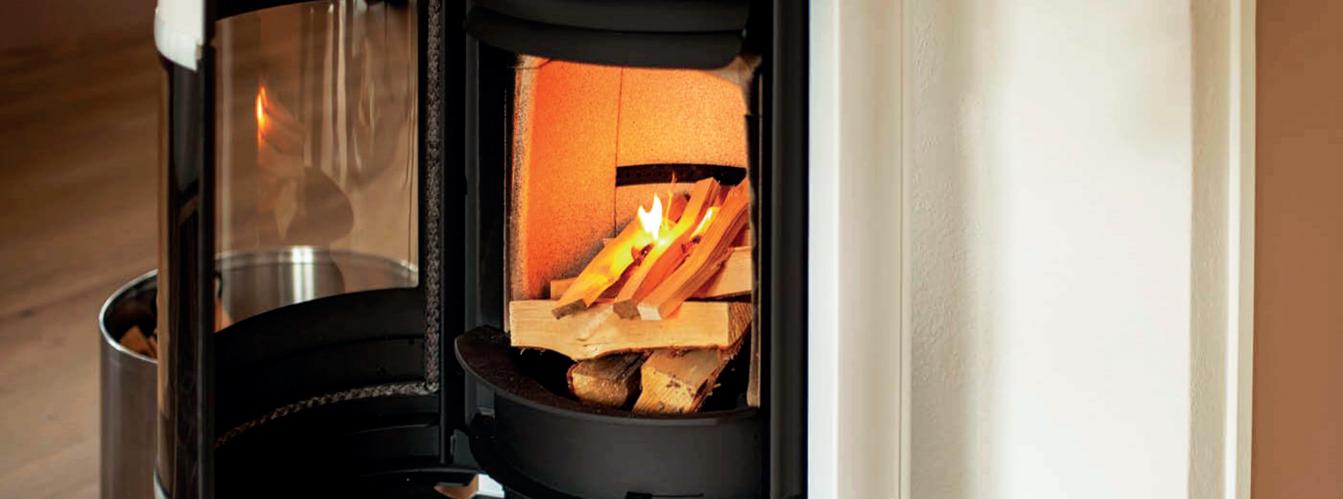
possible before they are wasted up the chimney.
Preheat the flue and appliance – The efficient combustion from the kindling allows as much heat to be utilised as is available, getting the flue up to temperature as fast as possible. This is important as any wasted fuel that enters the chimney before it reaches 125°C will condense back from a gas to a solid, from wood smoke to creosote/tar and stick to the inside walls of your chimney.
The ‘lattice’ formation maximises airflow through the kindling formation
Minimal tending – By setting all your fuel in one formation, you can light the fire and allow it to do what it needs to do without having to worry about adding on larger and larger pieces of wood until it has caught.
Aesthetically pleasing – Without filling the firebox with smoke, you can clearly see the fire as it catches.
By placing the easy-to-burn kindling atop our denser firewood, the kindling burns quickly and efficiently and doesn’t set alight the dense firewood below until there is enough heat for the reaction to take place. As around 80% of the heat we get from wood is the actual wood smoke, it is imperative that we do not release it and waste it up the chimney before it is ready to burn.
More efficiency – As there is only x amount of heat available for reactions to take place whilst things are getting up to temperature, limiting the amount of smoke released stops the excess gases competing for available energy in their quest to react with the available oxygen. By controlling the smoke release rate, we can burn as much of the wood gases as
The top-down method of fire-lighting offers a time-tested and reliable approach to building the most efficient fire possible. Time now to gather your firewood, follow the steps outlined above, and master lighting the perfect fire.
● Test your firewood to make sure it is seasoned properly – You can use a moisture meter for this. 20% moisture is the absolute maximum allowance but the aim should be to burn wood around the 10% mark
● Don’t be stingy on your kindling! –This is the #1 mistake many make when lighting their fires. Be generous and form a lattice of 3 of more layers of kindling

Building Your Top-Down Fire
1. Gather your dry (20% moisture content maximum) firewood, kindling, preferred firelighter (See which is best here) and your matches/lighter
2. Make sure all the air vents on your stove are on their most open settings
3. Begin by placing your large, dense firewood at the bottom of your stove, covering the entire grate/base. For an open fire, a minimum of 3 logs should be used
4. Layer your lattice formation atop the firewood base, covering it from one end to another and feed your firelighters into a few of the gaps. (See below Tip for Success)
5. Light the firelighters and close the door
6. Wait for the fire to establish and control as normal. No more tending will be required

● Try leaving your door on the latch
– This allows additional oxygen to be funnelled into the appliance so it can react with the wood gases. Not all stoves benefit from this so try it and monitor the results
● Experiment and adapt – Don’t be afraid to experiment and adjust your approach based on factors such as weather conditions and the type of wood available


























Hello dear readers. By the time you read this, there may well be fewer than 80 days until Christmas. I’ll just leave that there. Mind you, given the questionably brief summer we experienced, it seemed like Christmas was only ever just around the corner. For those who remember or care, I very much enjoyed my summer holidays, all 6 days of them. Thank you to those who attended my birthday celebrations; that was followed by a few days in Sète in the south. Staying on a boat and watching water jousting. Chilled during the day, party place at night. Naturally, I went home early… anyway, enough of my social life (that’s it for the year by the way), shall we crack on?
Freesat is not the same as Freeview. You cannot use a dedicated Freeview box for the reception of UK TV via satellite. Go for the one with ‘sat’ in the name.
I came across an unusual situation recently, but it might be worth mentioning to avoid anyone making the same mistake. A client purchased a ‘6 output’ LNB to run six cables from. However, two of the satellite boxes didn’t work properly whilst the other four did. Why? Because it was a ‘hybrid LNB’. This is a particular type which has four ‘standard’ outlets and two ‘wideband’ outlets to accommodate something like a Sky Q box or the latest Freesat+ receiver. The two wideband outlets do not work in the same way as the other four universal outlets. Effectively, the wideband outlets only send 50% of the available signals per outlet. Used together they provide 100% of the signals.
SATELLITE TV

THE FRENCH HOUSE I very much enjoyed my summer holidays, all 6 days of them
above, the client needed an 8 output LNB (leaving two spare outlets).
Did you know that on the Freesat website you can find full user manuals for most models of Freesat box. Not just the silly quick start guide you find in the box. Some can do a lot more than you might imagine. Just go to www.freesat.co.uk/help/product
To the best of my knowledge, you cannot purchase a ‘standard’ 6 output LNB. They come in 1s, 2s, 4s and 8s. So, in the case
Freesat
Please remember that I no longer cover the same areas as I used to. I cover a 90 mins radius of 79240. Google Maps will help you with this. Put in my postcode, put in yours and see what it says.





















































●






















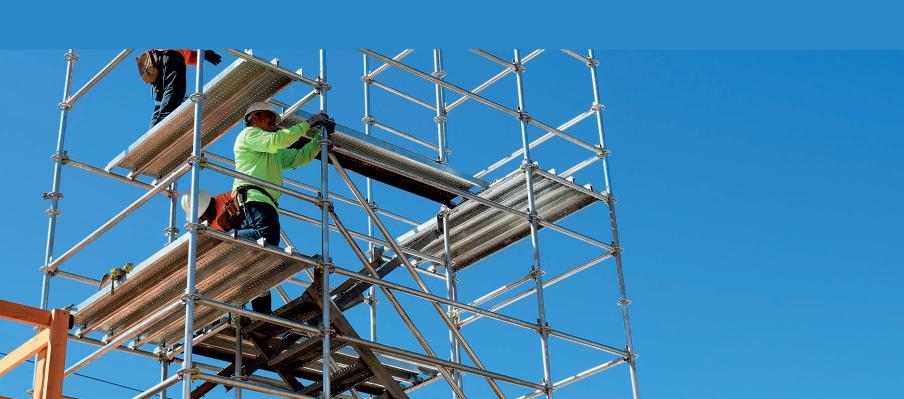








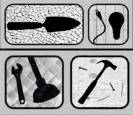











































We all need each other












